-
ADC32J2x Dual-Channel, 12-Bit, 50-MSPS to 160-MSPS, Analog-to-Digital Converter with JESD204B Interface
- 1 Features
- 2 Applications
- 3 Description
- 4 Revision History
- 5 Device Comparison Table
- 6 Pin Configuration and Functions
-
7 Specifications
- 7.1 Absolute Maximum Ratings
- 7.2 ESD Ratings
- 7.3 Recommended Operating Conditions
- 7.4 Thermal Information
- 7.5 Electrical Characteristics
- 7.6 Electrical Characteristics: ADC32J22, ADC32J23
- 7.7 Electrical Characteristics: ADC32J24, ADC32J25
- 7.8 AC Performance: ADC32J25
- 7.9 AC Performance: ADC32J24
- 7.10 AC Performance: ADC32J23
- 7.11 AC Performance: ADC32J22
- 7.12 Digital Characteristics
- 7.13 Timing Requirements
- 7.14 Typical Characteristics: ADC32J25
- 7.15 Typical Characteristics: ADC32J24
- 7.16 Typical Characteristics: ADC32J23
- 7.17 Typical Characteristics: ADC32J22
- 7.18 Typical Characteristics: Common Plots
- 7.19 Typical Characteristics: Contour Plots
- 8 Parameter Measurement Information
-
9 Detailed Description
- 9.1 Overview
- 9.2 Functional Block Diagram
- 9.3 Feature Description
- 9.4 Device Functional Modes
- 9.5 Programming
- 9.6
Register Maps
- 9.6.1 Summary of Special Mode Registers
- 9.6.2
Serial Register Descriptions
- 9.6.2.1 Register 01h (address = 01h)
- 9.6.2.2 Register 03h (address = 03h)
- 9.6.2.3 Register 04h (address = 04h)
- 9.6.2.4 Register 06h (address = 06h)
- 9.6.2.5 Register 07h (address = 07h)
- 9.6.2.6 Register 08h (address = 08h)
- 9.6.2.7 Register 09h (address = 09h)
- 9.6.2.8 Register 0Ah (address = 0Ah)
- 9.6.2.9 Register 0Bh (address = 0Bh)
- 9.6.2.10 Register 0Ch (address = 0Ch)
- 9.6.2.11 Register 0Dh (address = 0Dh)
- 9.6.2.12 Register 0Eh (address = 0Eh)
- 9.6.2.13 Register 0Fh (address = 0Fh)
- 9.6.2.14 Register 13h (address = 13h)
- 9.6.2.15 Register 15h (address = 15h)
- 9.6.2.16 Register 27h (address = 27h)
- 9.6.2.17 Register 2Ah (address = 2Ah)
- 9.6.2.18 Register 2Bh (address = 2Bh)
- 9.6.2.19 Register 2Fh (address = 2Fh)
- 9.6.2.20 Register 30h (address = 30h)
- 9.6.2.21 Register 31h (address = 31h)
- 9.6.2.22 Register 34h (address = 34h)
- 9.6.2.23 Register 3Ah (address = 3Ah)
- 9.6.2.24 Register 3Bh (address = 3Bh)
- 9.6.2.25 Register 3Ch (address = 3Ch)
- 9.6.2.26 Register 422h (address = 422h)
- 9.6.2.27 Register 434h (address = 434h)
- 9.6.2.28 Register 522h (address = 522h)
- 9.6.2.29 Register 534 (address = 534h)
- 10Applications and Implementation
- 11Power Supply Recommendations
- 12Layout
- 13Device and Documentation Support
- 14Mechanical, Packaging, and Orderable Information
- IMPORTANT NOTICE
Package Options
Mechanical Data (Package|Pins)
- RGZ|48
Thermal pad, mechanical data (Package|Pins)
- RGZ|48
Orderable Information
ADC32J2x Dual-Channel, 12-Bit, 50-MSPS to 160-MSPS, Analog-to-Digital Converter with JESD204B Interface
1 Features
- Dual Channel
- 12-Bit Resolution
- Single 1.8-V Supply
- Flexible Input Clock Buffer with Divide-by-1, -2, -4
- SNR = 70.3 dBFS, SFDR = 88 dBc at
fIN = 70 MHz - Ultralow Power Consumption:
- 227 mW/Ch at 160 MSPS
- Channel Isolation: 105 dB
- Internal Dither
- JESD204B Serial Interface:
- Subclass 0, 1, 2 Compliant up to 3.2 Gbps
- Supports One Lane per ADC up to 160 MSPS
- Support for Multichip Synchronization
- Pin-to-Pin Compatible with 14-Bit Version (ADC32J4X)
- Package: VQFN-48 (7 mm × 7 mm)
2 Applications
- Multi-Carrier, Multi-Mode Cellular Base Stations
- Radar and Smart Antenna Arrays
- Munitions Guidance
- Motor Control Feedback
- Network and Vector Analyzers
- Communications Test Equipment
- Nondestructive Testing
- Microwave Receivers
- Software Defined Radios (SDRs)
- Quadrature and Diversity Radio Receivers
3 Description
The ADC32J2x is a high-linearity, ultra-low power, dual-channel, 12-bit, 50-MSPS to 160-MSPS, analog-to-digital converter (ADC) family. The devices are designed specifically to support demanding, high input frequency signals with large dynamic range requirements. A clock input divider allows more flexibility for system clock architecture design and the SYSREF input enables complete system synchronization. The devices support JESD204B interfaces in order to reduce the number of interface lines, thus allowing for high system integration density. The JESD204B interface is a serial interface, where the data of each ADC are serialized and output over only one differential pair. An internal phase-locked loop (PLL) multiplies the incoming ADC sampling clock by 20 to derive the bit clock that is used to serialize the 12-bit data from each channel. The devices support subclass 1 with interface speeds up to 3.2 Gbps.
Device Information(1)
| PART NUMBER | PACKAGE | BODY SIZE (NOM) |
|---|---|---|
| ADC32J2X | VQFN (48) | 7.00 mm × 7.00 mm |
- For all available packages, see the package option addendum at the end of the datasheet.
FFT with Dither On
(fS = 160 MSPS, SNR = 70.3 dBFS, fIN = 10 MHz, SFDR = 92.6 dBc)
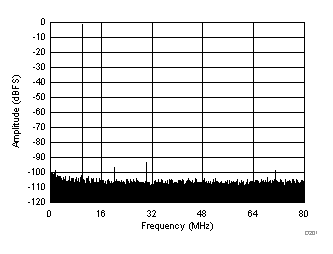
4 Revision History
Changes from * Revision (May 2015) to A Revision
- Changed from product preview to production dataGo
6 Pin Configuration and Functions

Pin Functions
| PIN | I/O | DESCRIPTION | |
|---|---|---|---|
| NAME | NO. | ||
| AVDD | 4, 5, 8, 9, 12, 17, 20, 25, 28, 29, 32, 39, 46 | I | Analog 1.8-V power supply |
| CLKM | 18 | I | Negative differential clock input for the ADC |
| CLKP | 19 | I | Positive differential clock input for the ADC |
| DAM | 48 | O | Negative serial JESD204B output for channel A |
| DAP | 47 | O | Positive serial JESD204B output for channel A |
| DBM | 45 | O | Negative serial JESD204B output for channel B |
| DBP | 44 | O | Positive serial JESD204B output for channel B |
| DVDD | 3,34 | I | Digital 1.8-V power supply |
| GND | PowerPAD™ | I | Ground, 0 V |
| INAM | 11 | I | Negative differential analog input for channel A |
| INAP | 10 | I | Positive differential analog input for channel A |
| INBM | 26 | I | Negative differential analog input for channel B |
| INBP | 27 | I | Positive differential analog input for channel B |
| NC | 2, 6, 7, 30, 31, 35, 37, 38, 40, 41 | — | Do not connect |
| OVRA | 1 | O | Overrange indicator for channel A |
| OVRB | 36 | O | Overrange indicator for channel B |
| PDN | 33 | I | Power-down control. This pin has an internal 150-kΩ pulldown resistor. |
| RESET | 21 | I | Hardware reset; active high. This pin has an internal 150-kΩ pulldown resistor. |
| SCLK | 13 | I | Serial interface clock input. This pin has an internal 150-kΩ pulldown resistor. |
| SDATA | 14 | I | Serial Interface data input. This pin has an internal 150-kΩ pulldown resistor. |
| SDOUT | 16 | O | Serial interface data output |
| SEN | 15 | I | Serial interface enable; active low. This pin has an internal 150-kΩ pullup resistor to AVDD. |
| SYNCM~ | 42 | I | Positive JESD204B synch input |
| SYNCP~ | 43 | I | Negative JESD204B synch input |
| SYSREFM | 23 | I | Negative external SYSREF input |
| SYSREFP | 22 | I | Positive external SYSREF input |
| VCM | 24 | O | Common-mode voltage output for analog inputs |
7 Specifications
7.1 Absolute Maximum Ratings
over operating free-air temperature range (unless otherwise noted)(1)| MIN | MAX | UNIT | ||
|---|---|---|---|---|
| Supply voltage range, AVDD | –0.3 | 2.1 | V | |
| Supply voltage range, DVDD | –0.3 | 2.1 | V | |
| Voltage applied to input pins: | INAP, INBP | –0.3 | AVDD + 0.3 | V |
| CLKP, CLKM | –0.3 | AVDD + 0.3 | V | |
| SYSREFP, SYSREFM, SYNCP~, SYNCM~ | –0.3 | AVDD + 0.3 | V | |
| SCLK, SEN, SDATA, RESET, PDN | –0.3 | AVDD + 0.3 | V | |
| Temperature range | Operating free-air, TA | –40 | 85 | °C |
| Operating junction, TJ | 125 | °C | ||
| Storage, Tstg | –65 | 150 | °C | |
7.2 ESD Ratings
| VALUE | UNIT | |||
|---|---|---|---|---|
| V(ESD) | Electrostatic discharge | Human body model (HBM), per ANSI/ESDA/JEDEC JS-001, all pins(1) | ±2000 | V |
7.3 Recommended Operating Conditions
over operating free-air temperature range (unless otherwise noted)| MIN | NOM | MAX | UNIT | |||
|---|---|---|---|---|---|---|
| SUPPLIES | ||||||
| AVDD | Analog supply voltage range | 1.7 | 1.8 | 1.9 | V | |
| DVDD | Digital supply voltage range | 1.7 | 1.8 | 1.9 | V | |
| ANALOG INPUT | ||||||
| VID | Differential input voltage | For input frequencies < 450 MHz | 2 | VPP | ||
| For input frequencies < 600 MHz | 1 | VPP | ||||
| VIC | Input common-mode voltage | VCM ± 0.025 | V | |||
| CLOCK INPUT | ||||||
| Input clock frequency | Sampling clock frequency | 25 | 160(1) | MSPS | ||
| Input clock amplitude (differential) | Sine wave, ac-coupled | 1.5 | V | |||
| LPECL, ac-coupled | 1.6 | V | ||||
| LVDS, ac-coupled | 0.7 | V | ||||
| Input clock duty cycle | 50% | |||||
| Input clock common-mode voltage | 0.95 | V | ||||
| DIGITAL OUTPUTS | ||||||
| CLOAD | Maximum external load capacitance from each output pin to GND | 3.3 | pF | |||
| RLOAD | Single-ended load resistance | 100 | Ω | |||
7.4 Thermal Information
| THERMAL METRIC(1) | ADC32J2x | UNIT | |
|---|---|---|---|
| RGZ (VQFN) | |||
| 48 PINS | |||
| RθJA | Junction-to-ambient thermal resistance | 25.7 | °C/W |
| RθJC(top) | Junction-to-case (top) thermal resistance | 18.9 | °C/W |
| RθJB | Junction-to-board thermal resistance | 3.0 | °C/W |
| ψJT | Junction-to-top characterization parameter | 0.2 | °C/W |
| ψJB | Junction-to-board characterization parameter | 3 | °C/W |
| RθJC(bot) | Junction-to-case (bottom) thermal resistance | 0.5 | °C/W |
7.5 Electrical Characteristics
Typical values are at TA = 25°C, full temperature range is TMIN = –40°C to TMAX = 85°C, Maximum sampling rate, 50% clock duty cycle, AVDD = DVDD = 1.8 V, and –1-dBFS differential input, unless otherwise noted.| PARAMETER | TEST CONDITIONS | MIN | TYP | MAX | UNIT | |
|---|---|---|---|---|---|---|
| ANALOG INPUT | ||||||
| Differential input full-scale | 2.0 | VPP | ||||
| Input resistance | Differential at dc | 6.5 | kΩ | |||
| Input capacitance | Differential at dc | 5.2 | pF | |||
| VCM common-mode voltage output | 0.95 | V | ||||
| VCM output current capability | 10 | mA | ||||
| Input common-mode current | Per analog input pin | 1.5 | µA/MSPS | |||
| Analog input bandwidth (3 dB) | 50-Ω differential source driving 50-Ω termination across INP and INM | 450 | MHz | |||
| DC ACCURACY | ||||||
| Offset error | –20 | 20 | mV | |||
| EG(REF) | Gain error as a result of internal reference inaccuracy alone | –3 | 3 | %FS | ||
| EG(CHAN) | Gain error of channel alone | ±1 | %FS | |||
| Temperature coefficient of EG(CHAN) | –0.017 | Δ%FS/°C | ||||
| CHANNEL-TO-CHANNEL ISOLATION | ||||||
| Crosstalk | fIN = 10 MHz | 105 | dB | |||
| fIN = 100 MHz | 105 | dB | ||||
| fIN = 200 MHz | 105 | dB | ||||
| fIN = 230 MHz | 105 | dB | ||||
| fIN = 300 MHz | 105 | dB | ||||
7.6 Electrical Characteristics: ADC32J22, ADC32J23
Typical values are at TA = 25°C, full temperature range is TMIN = –40°C to TMAX = 85°C, Maximum sampling rate, 50% clock duty cycle, AVDD = DVDD = 1.8 V, and –1-dBFS differential input, unless otherwise noted.| PARAMETER | ADC32J22 | ADC32J23 | UNIT | |||||
|---|---|---|---|---|---|---|---|---|
| MIN | TYP | MAX | MIN | TYP | MAX | |||
| ADC clock frequency | 50 | 80 | MSPS | |||||
| Resolution | 12 | 12 | Bits | |||||
| 1.8-V analog supply current | 134 | 267 | 152 | 272 | mA | |||
| 1.8-V digital supply current | 22 | 40 | 31 | 46 | mA | |||
| Total power dissipation | 281 | 435 | 329 | 450 | mW | |||
| Global power-down dissipation | 5 | 5 | mW | |||||
| Wake-up time from global power-down | 85 | 85 | µs | |||||
| Standby power-down dissipation | 99 | 105 | mW | |||||
| Wake-up time from standby power-down | 35 | 35 | µs | |||||
7.7 Electrical Characteristics: ADC32J24, ADC32J25
Typical values are at TA = 25°C, full temperature range is TMIN = –40°C to TMAX = 85°C, Maximum sampling rate, 50% clock duty cycle, AVDD = DVDD = 1.8 V, and –1-dBFS differential input, unless otherwise noted.| PARAMETER | ADC32J24 | ADC32J25 | UNIT | |||||
|---|---|---|---|---|---|---|---|---|
| MIN | TYP | MAX | MIN | TYP | MAX | |||
| ADC clock frequency | 125 | 160 | MSPS | |||||
| Resolution | 12 | 12 | Bits | |||||
| 1.8-V analog supply current | 177 | 292 | 192 | 302 | mA | |||
| 1.8-V digital supply current | 46 | 65 | 56 | 80 | mA | |||
| Total power dissipation | 401 | 535 | 454 | 560 | mW | |||
| Global power-down dissipation | 5 | 5 | mW | |||||
| Wake-up time from global power-down | 85 | 85 | µs | |||||
| Standby power-down dissipation | 112 | 118 | mW | |||||
| Wake-up time from standby power-down | 35 | 35 | µs | |||||
7.8 AC Performance: ADC32J25
Typical values are at TA = 25°C, full temperature range is TMIN = –40°C to TMAX = 85°C, ADC sampling rate = 160 MSPS, 50% clock duty cycle, AVDD = DVDD = 1.8 V, and –1-dBFS differential input, unless otherwise noted.| PARAMETER | TEST CONDITIONS | ADC32J25 (fS = 160 MSPS) | UNIT | ||||||
|---|---|---|---|---|---|---|---|---|---|
| DITHER ON | DITHER OFF | ||||||||
| MIN | TYP | MAX | MIN | TYP | MAX | ||||
| DYNAMIC AC CHARACTERISTICS | |||||||||
| SNR | Signal-to-noise ratio | fIN = 10 MHz | 70.3 | 70.5 | dBFS | ||||
| fIN = 70 MHz | 68 | 69.8 | 70.0 | ||||||
| fIN = 100 MHz | 69.5 | 69.7 | |||||||
| fIN = 170 MHz | 68.6 | 69.1 | |||||||
| fIN = 230 MHz | 67.8 | 68.3 | |||||||
| NSD | Noise spectral density (averaged across Nyquist zone) |
fIN = 10 MHz | 149.3 | 149.5 | dBFS/Hz | ||||
| fIN = 70 MHz | –147.5 | 148.8 | 149.0 | ||||||
| fIN = 100 MHz | 148.5 | 148.7 | |||||||
| fIN = 170 MHz | 147.7 | 148.1 | |||||||
| fIN = 230 MHz | 146.8 | 147.3 | |||||||
| SINAD | Signal-to-noise and distortion ratio | fIN = 10 MHz | 70.2 | 70.4 | dBFS | ||||
| fIN = 70 MHz | 67.3 | 69.7 | 69.9 | ||||||
| fIN = 100 MHz | 69.4 | 68.8 | |||||||
| fIN = 170 MHz | 68.4 | 68.8 | |||||||
| fIN = 230 MHz | 67.5 | 67.8 | |||||||
| ENOB | Effective number of bits | fIN = 10 MHz | 11.4 | 11.4 | Bits | ||||
| fIN = 70 MHz | 10.9 | 11.3 | 11.3 | ||||||
| fIN = 100 MHz | 11.2 | 11.3 | |||||||
| fIN = 170 MHz | 11.1 | 11.1 | |||||||
| fIN = 230 MHz | 10.9 | 10.9 | |||||||
| SFDR | Spurious-free dynamic range | fIN = 10 MHz | 91 | 88 | dBc | ||||
| fIN = 70 MHz | 78 | 86 | 85 | ||||||
| fIN = 100 MHz | 85 | 84 | |||||||
| fIN = 170 MHz | 83 | 82 | |||||||
| fIN = 230 MHz | 81 | 80 | |||||||
| HD2 | Second-order harmonic distortion | fIN = 10 MHz | 91 | 92 | dBc | ||||
| fIN = 70 MHz | 78 | 93 | 93 | ||||||
| fIN = 100 MHz | 92 | 93 | |||||||
| fIN = 170 MHz | 83 | 82 | |||||||
| fIN = 230 MHz | 81 | 80 | |||||||
| HD3 | Third-order harmonic distortion | fIN = 10 MHz | 91 | 88 | dBc | ||||
| fIN = 70 MHz | 78 | 86 | 85 | ||||||
| fIN = 100 MHz | 85 | 84 | |||||||
| fIN = 170 MHz | 91 | 87 | |||||||
| fIN = 230 MHz | 87 | 87 | |||||||
| Non HD2, HD3 |
Spurious-free dynamic range (excluding HD2, HD3) | fIN = 10 MHz | 99 | 95 | dBc | ||||
| fIN = 70 MHz | 87 | 98 | 94 | ||||||
| fIN = 100 MHz | 96 | 94 | |||||||
| fIN = 170 MHz | 91 | 90 | |||||||
| fIN = 230 MHz | 91 | 89 | |||||||
| THD | Total harmonic distortion | fIN = 10 MHz | 87 | 85 | dBc | ||||
| fIN = 70 MHz | 75 | 84 | 83 | ||||||
| fIN = 100 MHz | 83 | 82 | |||||||
| fIN = 170 MHz | 81 | 80 | |||||||
| fIN = 230 MHz | 78 | 77 | |||||||
| IMD3 | Two-tone, third-order intermodulation distortion | fIN1 = 45 MHz, fIN2 = 50 MHz |
91 | 91 | dBFS | ||||
| fIN1 = 185 MHz, fIN2 = 190 MHz |
86 | 86 | |||||||
| DNL | Differential nonlinearity | fIN = 70 MHz | ±0.1 | ±0.1 | LSBs | ||||
| INL | Integrated nonlinearity | fIN = 70 MHz | ±0.4 | ±0.4 | LSBs | ||||
7.9 AC Performance: ADC32J24
Typical values are at TA = 25°C, full temperature range is TMIN = –40°C to TMAX = 85°C, ADC sampling rate = 125 MSPS, 50% clock duty cycle, AVDD = DVDD = 1.8 V, and –1-dBFS differential input, unless otherwise noted.| PARAMETER | TEST CONDITIONS | ADC32J24 (fS = 125 MSPS) | UNIT | ||||||
|---|---|---|---|---|---|---|---|---|---|
| DITHER ON | DITHER OFF | ||||||||
| MIN | TYP | MAX | MIN | TYP | MAX | ||||
| DYNAMIC AC CHARACTERISTICS | |||||||||
| SNR | Signal-to-noise ratio | fIN = 10 MHz | 70.3 | 70.5 | dBFS | ||||
| fIN = 70 MHz | 68.8 | 70.1 | 70.3 | ||||||
| fIN = 100 MHz | 70.1 | 70.2 | |||||||
| fIN = 170 MHz | 69.4 | 69.8 | |||||||
| fIN = 230 MHz | 68.7 | 69.2 | |||||||
| NSD | Noise spectral density (averaged across Nyquist zone) |
fIN = 10 MHz | 148.3 | 148.5 | dBFS/Hz | ||||
| fIN = 70 MHz | –146.8 | 148.1 | 148.3 | ||||||
| fIN = 100 MHz | 148.0 | 148.2 | |||||||
| fIN = 170 MHz | 147.3 | 147.8 | |||||||
| fIN = 230 MHz | 146.7 | 147.2 | |||||||
| SINAD | Signal-to-noise and distortion ratio | fIN = 10 MHz | 70.3 | 70.4 | dBFS | ||||
| fIN = 70 MHz | 67.6 | 70.1 | 70.3 | ||||||
| fIN = 100 MHz | 70.0 | 70.1 | |||||||
| fIN = 170 MHz | 69.2 | 69.6 | |||||||
| fIN = 230 MHz | 68.3 | 68.8 | |||||||
| ENOB | Effective number of bits | fIN = 10 MHz | 11.4 | 11.4 | Bits | ||||
| fIN = 70 MHz | 11 | 11.4 | 11.4 | ||||||
| fIN = 100 MHz | 11.3 | 11.4 | |||||||
| fIN = 170 MHz | 11.2 | 11.3 | |||||||
| fIN = 230 MHz | 11.1 | 11.1 | |||||||
| SFDR | Spurious-free dynamic range | fIN = 10 MHz | 93 | 92 | dBc | ||||
| fIN = 70 MHz | 78.5 | 91 | 90 | ||||||
| fIN = 100 MHz | 90 | 90 | |||||||
| fIN = 170 MHz | 85 | 84 | |||||||
| fIN = 230 MHz | 82 | 81 | |||||||
| HD2 | Second-order harmonic distortion | fIN = 10 MHz | 93 | 92 | dBc | ||||
| fIN = 70 MHz | 78.5 | 91 | 90 | ||||||
| fIN = 100 MHz | 90 | 90 | |||||||
| fIN = 170 MHz | 85 | 84 | |||||||
| fIN = 230 MHz | 82 | 81 | |||||||
| HD3 | Third-order harmonic distortion | fIN = 10 MHz | 96 | 92 | dBc | ||||
| fIN = 70 MHz | 80 | 95 | 90 | ||||||
| fIN = 100 MHz | 95 | 92 | |||||||
| fIN = 170 MHz | 88 | 86 | |||||||
| fIN = 230 MHz | 90 | 93 | |||||||
| Non HD2, HD3 |
Spurious-free dynamic range (excluding HD2, HD3) | fIN = 10 MHz | 98 | 96 | dBc | ||||
| fIN = 70 MHz | 87 | 99 | 95 | ||||||
| fIN = 100 MHz | 97 | 96 | |||||||
| fIN = 170 MHz | 97 | 94 | |||||||
| fIN = 230 MHz | 96 | 91 | |||||||
| THD | Total harmonic distortion | fIN = 10 MHz | 91 | 88 | dBc | ||||
| fIN = 70 MHz | 75 | 89 | 87 | ||||||
| fIN = 100 MHz | 88 | 88 | |||||||
| fIN = 170 MHz | 83 | 82 | |||||||
| fIN = 230 MHz | 80 | 79 | |||||||
| IMD3 | Two-tone, third-order intermodulation distortion | fIN1 = 45 MHz, fIN2 = 50 MHz |
91 | 91 | dBFS | ||||
| fIN1 = 185 MHz, fIN2 = 190 MHz |
86 | 86 | |||||||
| DNL | Differential nonlinearity | fIN = 70 MHz | ±0.1 | ±0.1 | LSBs | ||||
| INL | Integrated nonlinearity | fIN = 70 MHz | ±0.4 | ±0.4 | LSBs | ||||
7.10 AC Performance: ADC32J23
Typical values are at TA = 25°C, full temperature range is TMIN = –40°C to TMAX = 85°C, ADC sampling rate = 80 MSPS, 50% clock duty cycle, AVDD = DVDD = 1.8 V, and –1-dBFS differential input, unless otherwise noted.| PARAMETER | TEST CONDITIONS | ADC32J23 (fS = 80 MSPS) | UNIT | ||||||
|---|---|---|---|---|---|---|---|---|---|
| DITHER ON | DITHER OFF | ||||||||
| MIN | TYP | MAX | MIN | TYP | MAX | ||||
| DYNAMIC AC CHARACTERISTICS | |||||||||
| SNR | Signal-to-noise ratio | fIN = 10 MHz | 70.3 | 70.4 | dBFS | ||||
| fIN = 70 MHz | 68.7 | 70.1 | 70.2 | ||||||
| fIN = 100 MHz | 70.0 | 70.2 | |||||||
| fIN = 170 MHz | 69.6 | 69.9 | |||||||
| fIN = 230 MHz | 69.1 | 69.3 | |||||||
| NSD | Noise spectral density (averaged across Nyquist zone) |
fIN = 10 MHz | 146.3 | 146.4 | dBFS/Hz | ||||
| fIN = 70 MHz | –144.8 | 146.2 | 146.3 | ||||||
| fIN = 100 MHz | 146.0 | 146.2 | |||||||
| fIN = 170 MHz | 145.6 | 145.9 | |||||||
| fIN = 230 MHz | 145.1 | 145.3 | |||||||
| SINAD | Signal-to-noise and distortion ratio | fIN = 10 MHz | 70.2 | 70.4 | dBFS | ||||
| fIN = 70 MHz | 67.6 | 70.1 | 70.3 | ||||||
| fIN = 100 MHz | 70.0 | 70.1 | |||||||
| fIN = 170 MHz | 69.5 | 69.7 | |||||||
| fIN = 230 MHz | 68.7 | 69.0 | |||||||
| ENOB | Effective number of bits | fIN = 10 MHz | 11 | 11.4 | 11.4 | Bits | |||
| fIN = 70 MHz | 11.4 | 11.4 | |||||||
| fIN = 100 MHz | 11.3 | 11.3 | |||||||
| fIN = 170 MHz | 11.2 | 11.3 | |||||||
| fIN = 230 MHz | 11.1 | 11.1 | |||||||
| SFDR | Spurious-free dynamic range | fIN = 10 MHz | 96 | 92 | dBc | ||||
| fIN = 70 MHz | 79.5 | 95 | 92 | ||||||
| fIN = 100 MHz | 91 | 88 | |||||||
| fIN = 170 MHz | 85 | 84 | |||||||
| fIN = 230 MHz | 81 | 80 | |||||||
| HD2 | Second-order harmonic distortion | fIN = 10 MHz | 96 | 95 | dBc | ||||
| fIN = 70 MHz | 79.5 | 95 | 94 | ||||||
| fIN = 100 MHz | 94 | 92 | |||||||
| fIN = 170 MHz | 85 | 84 | |||||||
| fIN = 230 MHz | 81 | 80 | |||||||
| HD3 | Third-order harmonic distortion | fIN = 10 MHz | 98 | 92 | dBc | ||||
| fIN = 70 MHz | 81 | 99 | 92 | ||||||
| fIN = 100 MHz | 91 | 88 | |||||||
| fIN = 170 MHz | 87 | 85 | |||||||
| fIN = 230 MHz | 83 | 82 | |||||||
| Non HD2, HD3 |
Spurious-free dynamic range (excluding HD2, HD3) | fIN = 10 MHz | 99 | 92 | dBc | ||||
| fIN = 70 MHz | 87 | 98 | 92 | ||||||
| fIN = 100 MHz | 97 | 92 | |||||||
| fIN = 170 MHz | 95 | 92 | |||||||
| fIN = 230 MHz | 95 | 92 | |||||||
| THD | Total harmonic distortion | fIN = 10 MHz | 93 | 90 | dBc | ||||
| fIN = 70 MHz | 77 | 93 | 89 | ||||||
| fIN = 100 MHz | 88 | 85 | |||||||
| fIN = 170 MHz | 82 | 81 | |||||||
| fIN = 230 MHz | 79 | 78 | |||||||
| IMD3 | Two-tone, third-order intermodulation distortion | fIN1 = 45 MHz, fIN2 = 50 MHz |
90 | 90 | dBFS | ||||
| fIN1 = 185 MHz, fIN2 = 190 MHz |
89 | 89 | |||||||
| DNL | Differential nonlinearity | fIN = 70 MHz | ±0.1 | ±0.1 | LSBs | ||||
| INL | Integrated nonlinearity | fIN = 70 MHz | ±0.4 | ±0.4 | LSBs | ||||
7.11 AC Performance: ADC32J22
Typical values are at TA = 25°C, full temperature range is TMIN = –40°C to TMAX = 85°C, ADC sampling rate = 50 MSPS, 50% clock duty cycle, AVDD = DVDD = 1.8 V, and –1-dBFS differential input, unless otherwise noted.| PARAMETER | TEST CONDITIONS | ADC32J22 (fS = 50 MSPS) | UNIT | ||||||
|---|---|---|---|---|---|---|---|---|---|
| DITHER ON | DITHER OFF | ||||||||
| MIN | TYP | MAX | MIN | TYP | MAX | ||||
| DYNAMIC AC CHARACTERISTICS | |||||||||
| SNR | Signal-to-noise ratio | fIN = 10 MHz | 69.3 | 70.2 | 70.3 | dBFS | |||
| fIN = 70 MHz | 70.0 | 70.1 | |||||||
| fIN = 100 MHz | 69.9 | 70.0 | |||||||
| fIN = 170 MHz | 69.4 | 69.7 | |||||||
| fIN = 230 MHz | 68.0 | 68.1 | |||||||
| NSD | Noise spectral density (averaged across Nyquist zone) |
fIN = 10 MHz | –143.3 | 144.1 | 144.3 | dBFS/Hz | |||
| fIN = 70 MHz | 143.9 | 144.1 | |||||||
| fIN = 100 MHz | 143.8 | 144.0 | |||||||
| fIN = 170 MHz | 143.4 | 143.7 | |||||||
| fIN = 230 MHz | 141.9 | 142.1 | |||||||
| SINAD | Signal-to-noise and distortion ratio | fIN = 10 MHz | 68.1 | 70.1 | 70.2 | dBFS | |||
| fIN = 70 MHz | 69.9 | 70.0 | |||||||
| fIN = 100 MHz | 69.8 | 69.9 | |||||||
| fIN = 170 MHz | 69.2 | 69.5 | |||||||
| fIN = 230 MHz | 67.6 | 67.6 | |||||||
| ENOB | Effective number of bits | fIN = 10 MHz | 11 | 11.4 | 11.4 | Bits | |||
| fIN = 70 MHz | 11.3 | 11.3 | |||||||
| fIN = 100 MHz | 11.3 | 11.3 | |||||||
| fIN = 170 MHz | 11.2 | 11.2 | |||||||
| fIN = 230 MHz | 10.9 | 10.9 | |||||||
| SFDR | Spurious-free dynamic range | fIN = 10 MHz | 80.5 | 95 | 92 | dBc | |||
| fIN = 70 MHz | 94 | 90 | |||||||
| fIN = 100 MHz | 91 | 89 | |||||||
| fIN = 170 MHz | 85 | 85 | |||||||
| fIN = 230 MHz | 82 | 82 | |||||||
| HD2 | Second-order harmonic distortion | fIN = 10 MHz | 80.5 | 96 | 95 | dBc | |||
| fIN = 70 MHz | 98 | 97 | |||||||
| fIN = 100 MHz | 92 | 91 | |||||||
| fIN = 170 MHz | 85 | 85 | |||||||
| fIN = 230 MHz | 82 | 82 | |||||||
| HD3 | Third-order harmonic distortion | fIN = 10 MHz | 81 | 95 | 92 | dBc | |||
| fIN = 70 MHz | 94 | 90 | |||||||
| fIN = 100 MHz | 91 | 89 | |||||||
| fIN = 170 MHz | 88 | 88 | |||||||
| fIN = 230 MHz | 82 | 82 | |||||||
| Non HD2, HD3 |
Spurious-free dynamic range (excluding HD2, HD3) | fIN = 10 MHz | 87 | 98 | 91 | dBc | |||
| fIN = 70 MHz | 95 | 92 | |||||||
| fIN = 100 MHz | 90 | 90 | |||||||
| fIN = 170 MHz | 96 | 91 | |||||||
| fIN = 230 MHz | 93 | 91 | |||||||
| THD | Total harmonic distortion | fIN = 10 MHz | 78 | 92 | 88 | dBc | |||
| fIN = 70 MHz | 91 | 87 | |||||||
| fIN = 100 MHz | 88 | 86 | |||||||
| fIN = 170 MHz | 83 | 82 | |||||||
| fIN = 230 MHz | 78 | 78 | |||||||
| IMD3 | Two-tone, third-order intermodulation distortion | fIN1 = 45 MHz, fIN2 = 50 MHz |
89 | 89 | dBFS | ||||
| fIN1 = 185 MHz, fIN2 = 190 MHz |
86 | 86 | |||||||
| DNL | Differential nonlinearity | fIN = 70 MHz | ±0.1 | ±0.1 | LSBs | ||||
| INL | Integrated nonlinearity | fIN = 70 MHz | ±0.4 | ±0.4 | LSBs | ||||
7.12 Digital Characteristics
The dc specifications refer to the condition where the digital outputs are not switching, but are permanently at a valid logic level 0 or 1. AVDD = DVDD = 1.8 V and –1-dBFS differential input, unless otherwise noted.| PARAMETER | TEST CONDITIONS | MIN | TYP | MAX | UNIT | |
|---|---|---|---|---|---|---|
| DIGITAL INPUTS (RESET, SCLK, SEN, SDATA, PDN)(1) | ||||||
| VIH | High-level input voltage | All digital inputs support 1.8-V and 3.3-V logic levels | 1.2 | V | ||
| VIL | Low-level input voltage | All digital inputs support 1.8-V and 3.3-V logic levels | 0.4 | V | ||
| IIH | High-level input current | SEN | 0 | µA | ||
| RESET, SCLK, SDATA, PDN | 10 | µA | ||||
| IIL | Low-level input current | SEN | 10 | µA | ||
| RESET, SCLK, SDATA, PDN | 0 | µA | ||||
| DIGITAL INPUTS (SYNCP~, SYNCM~, SYSREFP, SYSREFM) | ||||||
| VIH | High-level input voltage | 1.3 | V | |||
| VIL | Low-level input voltage | 0.5 | V | |||
| V(CM_DIG) | Common-mode voltage for SYNC~ and SYSREF | 0.9 | V | |||
| DIGITAL OUTPUTS (SDOUT, OVRA, OVRB) | ||||||
| VOH | High-level output voltage | DVDD – 0.1 | DVDD | V | ||
| VOL | Low-level output voltage | 0.1 | V | |||
| DIGITAL OUTPUTS (JESD204B Interface: DxP, DxM)(2) | ||||||
| VOH | High-level output voltage | AVDD | V | |||
| VOL | Low-level output voltage | AVDD – 0.4 | V | |||
| VOD | Output differential voltage | 0.4 | V | |||
| VOC | Output common-mode voltage | AVDD – 0.2 | V | |||
| Transmitter short-circuit current | Transmitter pins shorted to any voltage between –0.25 V and 1.45 V | –100 | 100 | mA | ||
| zos | Single-ended output impedance | 50 | Ω | |||
| Output capacitance | Output capacitance inside the device, from either output to ground |
2 | pF | |||
7.13 Timing Requirements
Typical values are at 25°C, AVDD = DVDD = 1.8 V, and –1-dBFS differential input, unless otherwise noted. Minimum and maximum values are across the full temperature range: TMIN = –40°C to TMAX = 85°C. See Figure 143.| MIN | TYP | MAX | UNIT | |||||
|---|---|---|---|---|---|---|---|---|
| SAMPLE TIMING CHARACTERISTICS | ||||||||
| Aperture delay | 0.85 | 1.25 | 1.65 | ns | ||||
| Aperture delay matching between two channels on the same device | ±70 | ps | ||||||
| Aperture delay matching between two devices at the same temperature and supply voltage | ±150 | ps | ||||||
| Aperture jitter | 200 | fS rms | ||||||
| Wake-up time to valid data after coming out of STANDBY mode | 35 | 100 | µs | |||||
| Wake-up time to valid data after coming out of global power-down | 85 | 300 | µs | |||||
| tSU_SYNC~ | Setup time for SYNC~ referenced to input clock rising edge | 1 | ns | |||||
| tH_SYNC~ | Hold time for SYNC~ referenced to input clock rising edge | 100 | ps | |||||
| tSU_SYSREF | Setup time for SYSREF referenced to input clock rising edge | 1 | ns | |||||
| tH_SYSREF | Hold time for SYSREF referenced to input clock rising edge | 100 | ps | |||||
| CML OUTPUT TIMING CHARACTERISTICS | ||||||||
| Unit interval | 320 | 1667 | ps | |||||
| Serial output data rate | 3.125 | Gbps | ||||||
| Total jitter: 3.125 Gbps (20X mode, fS = 156.25 MSPS) | 0.3 | P-PUI | ||||||
| tR, tF | Data rise time, data fall time: rise and fall times measured from 20% to 80%, differential output waveform, 600 Mbps ≤ bit rate ≤ 3.125 Gbps |
105 | ps | |||||
Table 1. Latency in Different Modes(1)(2)
| MODE | PARAMETER | LATENCY (N Cycles) | TYPICAL DATA DELAY (tD, ns) |
|---|---|---|---|
| 20X | ADC latency | 17 | 0.29 × tS + 3 |
| Normal OVR latency | 9 | 0.5 × tS + 2 | |
| Fast OVR latency | 7 | 0.5 × tS + 2 | |
| From SYNC~ falling edge to CGS phase(3) | 15 | 0.3 × tS + 4 | |
| From SYNC~ rising edge to ILA sequence(4) | 17 | 0.3 × tS + 4 | |
| 40X | ADC latency | 16 | 0.85 × tS + 3.9 |
| Normal OVR latency | 9 | 0.5 × tS + 2 | |
| Fast OVR latency | 7 | 0.5 × tS + 2 | |
| From SYNC~ falling edge to CGS phase(3) | 14 | 0.9 × tS + 4 | |
| From SYNC~ rising edge to ILA sequence(4) | 12 | 0.9 × tS + 4 |
7.14 Typical Characteristics: ADC32J25
Typical values are at TA = 25°C, ADC sampling rate = 160 MSPS, 50% clock duty cycle, AVDD = DVDD = 1.8 V, –1-dBFS differential input, 2-VPP full-scale, 32k-point FFT, dither enabled, and special modes written, unless otherwise noted.
| fS = 160 MSPS, SNR = 70.3 dBFS, fIN = 10 MHz, SFDR = 92.6 dBc |

| fS = 160 MSPS, SNR = 69.8 dBFS, fIN = 70 MHz, SFDR = 86 dBc |

| fS = 160 MSPS, SNR = 69.1 dBFS, fIN = 170 MHz, SFDR = 83 dBc |

| fS = 160 MSPS, SNR = 68.1 dBFS, fIN = 270 MHz, SFDR = 78.6 dBc |

| fS = 160 MSPS, SNR = 62.9 dBFS, fIN = 450 MHz, SFDR = 66 dBc |

| fS = 160 MSPS, IMD = 92.3 dBFS, fIN1 = 46 MHz, fIN2 = 50 MHz |
(–7 dBFS at 46 MHz and 50 MHz)

| fS = 160 MSPS, IMD = 82.5 dBFS, fIN1 = 185 MHz, fIN2 = 190 MHz |
(–7 dBFS at 185 MHz and 190 MHz)

(46 MHz and 50 MHz)
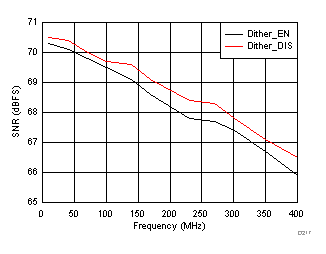
Input Frequency

Digital Gain and Input Frequency
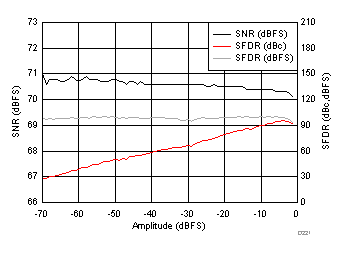
(30 MHz)

(30 MHz)
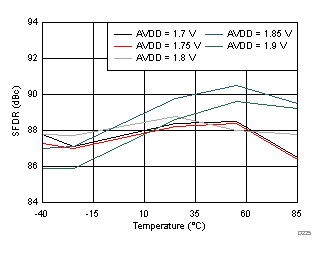
AVDD Supply and Temperature

DVDD Supply and Temperature

(40 MHz)

(40 MHz)

| RMS noise = 1.3 LSBs |

| fS = 160 MSPS, SNR = 70.5 dBFS, fIN = 10 MHz, SFDR = 92.6 dBc |

| fS = 160 MSPS, SNR = 70.1 dBFS, fIN = 70 MHz, SFDR = 85 dBc |

| fS = 160 MSPS, SNR = 69.3 dBFS, fIN = 170 MHz, SFDR = 83 dBc |
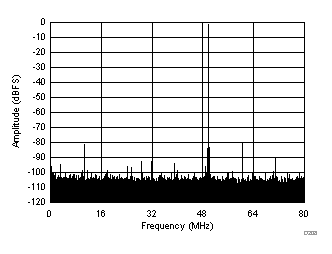
| fS = 160 MSPS, SNR = 68.6 dBFS, fIN = 270 MHz, SFDR = 78.9 dBc |
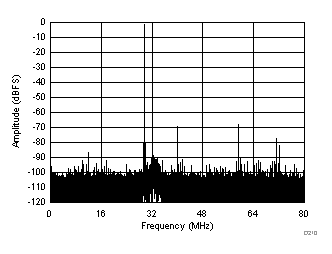
| fS = 160 MSPS, SNR = 63 dBFS, fIN = 450 MHz, SFDR = 66.6 dBc |

| fS = 160 MSPS, IMD = 99.3 dBFS, fIN1 = 46 MHz, fIN2 = 50 MHz |
(–36 dBFS at 46 MHz and 50 MHz)

| fS = 160 MSPS, IMD = 98.9 dBFS, fIN1 = 185 MHz, fIN2 = 190 MHz |
(–36 dBFS at 185 MHz and 190 MHz)

(185 MHz and 190 MHz)

Input Frequency

Digital Gain and Input Frequency

(170 MHz)


AVDD Supply and Temperature
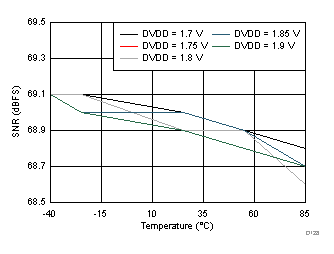
DVDD Supply and Temperature

(150 MHz)
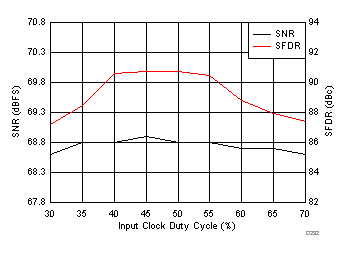
(150 MHz)
7.15 Typical Characteristics: ADC32J24
Typical values are at TA = 25°C, ADC sampling rate = 125 MSPS, 50% clock duty cycle, AVDD = DVDD = 1.8 V, –1-dBFS differential input, 2-VPP full-scale, and 32k-point FFT, unless otherwise noted.
| fS = 125 MSPS, SNR = 70.2 dBFS, fIN = 10 MHz, SFDR = 99.3 dBc |

| fS = 125 MSPS, SNR = 70 dBFS, fIN = 70 MHz, SFDR = 91 dBc | ||

| fS = 125 MSPS, SNR = 69.3 dBFS, fIN = 170 MHz, SFDR = 85 dBc |
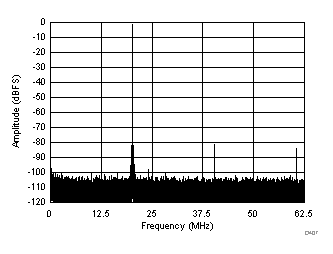
| fS = 125 MSPS, SNR = 68.8 dBFS, fIN = 270 MHz, SFDR = 80.5 dBc |

| fS = 125 MSPS, SNR = 63.5 dBFS, fIN = 450 MHz, SFDR = 68.6 dBc |
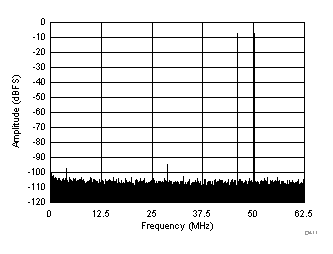
| fS = 125 MSPS, IMD = 94.7 dBFS, fIN1 = 46 MHz, fIN2 = 50 MHz |
(–7dBFS at 46 MHz and 50 MHz)
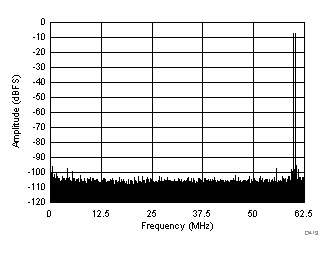
| fS = 125 MSPS, IMD = 96.2 dBFS, fIN1 = 185 MHz, fIN2 = 190 MHz |
(–7 dBFS at 185 MHz and 190 MHz)

(46 MHz and 50 MHz)

Input Frequency

Digital Gain and Input Frequency
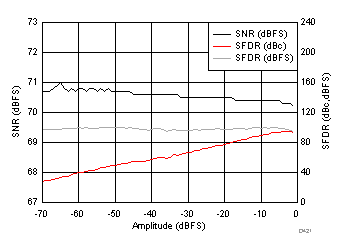
(30 MHz)

(30 MHz)
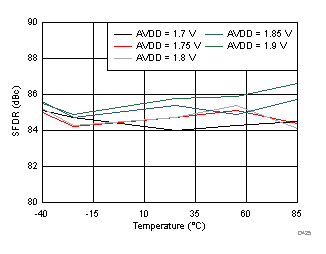
AVDD Supply and Temperature

DVDD Supply and Temperature

(40 MHz)

(40 MHz)
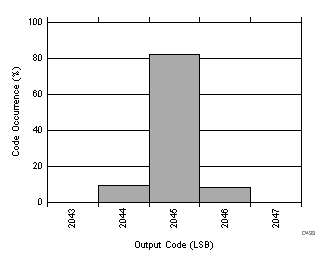
| RMS noise = 1.4 LSBs |

| fS = 125 MSPS, SNR = 70.6 dBFS, fIN = 10 MHz, SFDR = 93.8 dBc |
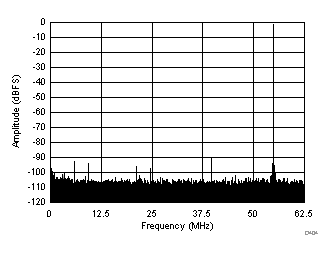
| fS = 125 MSPS, SNR = 70.2 dBFS, fIN = 70 MHz, SFDR = 90 dBc |

| fS = 125 MSPS, SNR = 69.9 dBFS, fIN = 70 MHz, SFDR = 84 dBc |

| fS = 125 MSPS, SNR = 69.3 dBFS, fIN = 270 MHz, SFDR = 79.9 dBc |

| fS = 125 MSPS, SNR = 63.8 dBFS, fIN = 450 MHz, SFDR = 68.8 dBc |

| fS = 125 MSPS, IMD = 98.73 dBFS, fIN1 = 46 MHz, fIN2 = 50 MHz |
(–36 dBFS at 46 MHz and 50 MHz)

| fS = 125 MSPS, IMD = 97 dBFS, fIN1 = 185 MHz, fIN2 = 190 MHz |
(–36 dBFS at 185 MHz and 190 MHz)

(185 MHz and 190 MHz)

Input Frequency

Digital Gain and Input Frequency

(170 MHz)


AVDD Supply and Temperature

DVDD Supply and Temperature
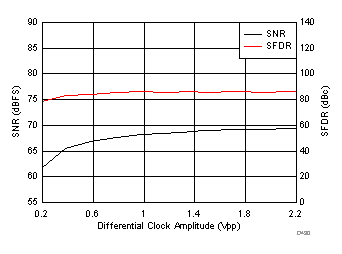
(150 MHz)

(150 MHz)
7.16 Typical Characteristics: ADC32J23
Typical values are at TA = 25°C, ADC sampling rate = 80 MSPS, 50% clock duty cycle, AVDD = DVDD = 1.8 V, –1-dBFS differential input, 2-VPP full-scale, and 32k-point FFT, unless otherwise noted.
| fS = 80 MSPS, SNR = 70.1 dBFS, fIN = 10 MHz, SFDR = 95.4 dBc |

| fS = 80 MSPS, SNR = 70.1 dBFS, fIN = 70 MHz, SFDR = 93 dBc |

| fS = 80 MSPS, SNR = 69.3 dBFS, fIN = 170 MHz, SFDR = 86 dBc |
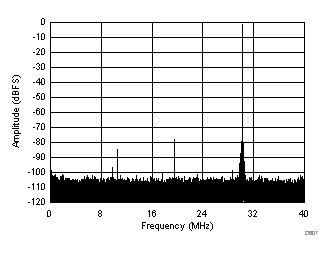
| fS = 80 MSPS, SNR = 68.9 dBFS, fIN = 270 MHz, SFDR = 76.9 dBc |

| fS = 80 MSPS, SNR = 62.7 dBFS, fIN = 450 MHz, SFDR = 67.6 dBc |

| fS = 80 MSPS, IMD = 96 dBFS, fIN1 = 46 MHz, fIN2 = 50 MHz |
(–7 dBFS at 46 MHz and 50 MHz)
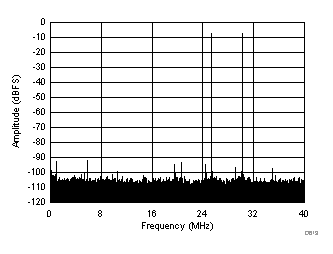
| fS = 80 MSPS, IMD = 92.1 dBFS, fIN1 = 185 MHz, fIN2 = 190 MHz |
(–7 dBFS at 185 MHz and 190 MHz)

(46 MHz and 50 MHz)

Input Frequency

Digital Gain and Input Frequency

(30 MHz)

(30 MHz)

AVDD Supply and Temperature

DVDD Supply and Temperature

(40 MHz)

(40 MHz)

| RMS noise = 1.4 LSBs |

| fS = 80 MSPS, SNR = 70.4 dBFS, fIN = 10 MHz, SFDR = 89.7 dBc |

| fS = 80 MSPS, SNR = 70.3 dBFS, fIN = 70 MHz, SFDR = 92 dBc |

| fS = 80 MSPS, SNR = 69.6 dBFS, fIN = 10 MHz, SFDR = 85 dBc | ||

| fS = 80 MSPS, SNR = 69 dBFS, fIN = 270 MHz, SFDR = 76.5 dBc |

| fS = 80 MSPS, SNR = 61.8 dBFS, fIN = 450 MHz, SFDR = 67.4 dBc |

| fS = 80 MSPS, IMD = 98.5 dBFS, fIN1 = 46 MHz, fIN2 = 50 MHz |
(–36 dBFS at 46 MHz and 50 MHz)

| fS = 80 MSPS, IMD = 97.5 dBFS, fIN1 = 185 MHz, fIN2 = 190 MHz |
(–36 dBFS at 185 MHz and 190 MHz)

(185 MHz and 190 MHz)

Input Frequency

Digital Gain and Input Frequency

(170 MHz)


AVDD Supply and Temperature
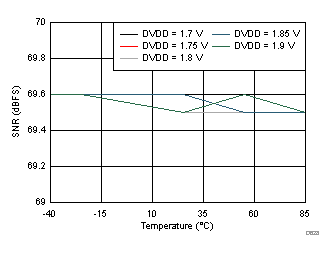
DVDD Supply and Temperature
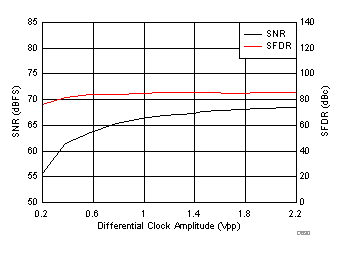
(150 MHz)
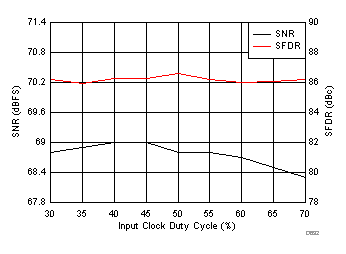
(150 MHz)
7.17 Typical Characteristics: ADC32J22
Typical values are at TA = 25°C, ADC sampling rate = 50 MSPS, 50% clock duty cycle, AVDD = DVDD = 1.8 V, –1-dBFS differential input, 2-VPP full-scale, and 32k-point FFT, unless otherwise noted.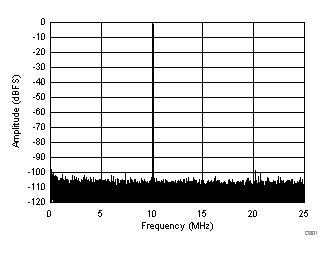
| fS = 50 MSPS, SNR = 70.2 dBFS, fIN = 10 MHz, SFDR = 97.6 dBc |

| fS = 50 MSPS, SNR = 69.9 dBFS, fIN = 70 MHz, SFDR = 92 dBc |

| fS = 50 MSPS, SNR = 68.6 dBFS, fIN = 170 MHz, SFDR = 86 dBc |
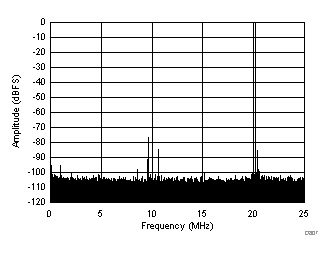
| fS = 50 MSPS, SNR = 68.4 dBFS, fIN = 270 MHz, SFDR = 75.7 dBc |

| fS = 50 MSPS, SNR = 65.3 dBFS, fIN = 450 MHz, SFDR = 67.4 dBc |

| fS = 50 MSPS, IMD = 90.2 dBFS, fIN1 = 46 MHz, fIN2 = 50 MHz |
(–7dBFS at 46 MHz and 50 MHz)
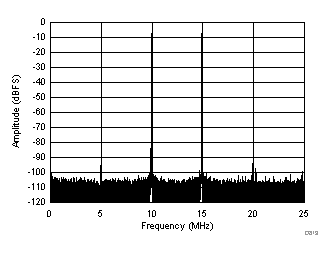
| fS = 50 MSPS, IMD = 91.2 dBFS, fIN1 = 185 MHz, fIN2 = 190 MHz |
(–7 dBFS at 185 MHz and 190 MHz)

(46 MHz and 50 MHz)

Input Frequency
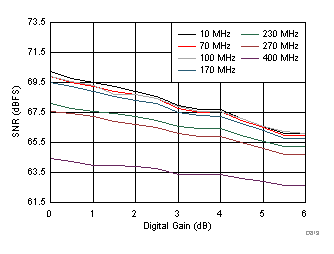
Digital Gain and Input Frequency
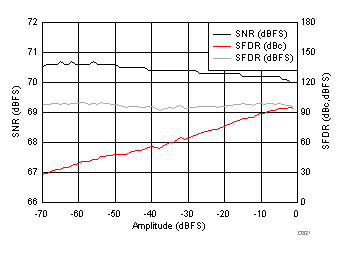
(30 MHz)


AVDD Supply and Temperature
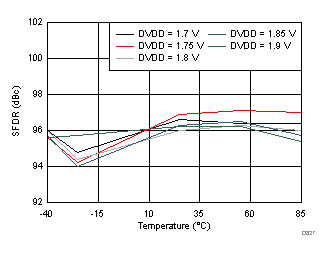
DVDD Supply and Temperature

(40 MHz)
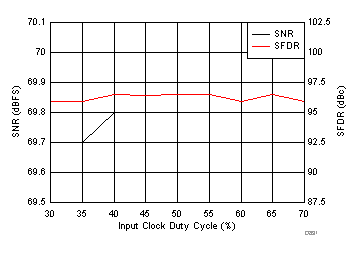
(40 MHz)

| RMS noise = 1.3 LSBs |
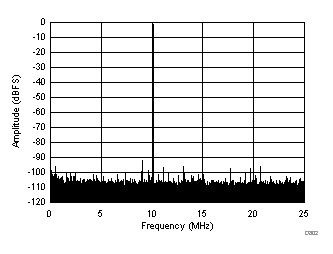
| fS = 50 MSPS, SNR = 70.4 dBFS, fIN = 10 MHz, SFDR = 90.8 dBc |

| fS = 50 MSPS, SNR = 70.1 dBFS, fIN = 70 MHz, SFDR = 91 dBc |

| fS = 50 MSPS, SNR = 69.1 dBFS, fIN = 170 MHz, SFDR = 85 dBc |

| fS = 50 MSPS, SNR = 68.6 dBFS, fIN = 270 MHz, SFDR = 75.6 dBc |

| fS = 50 MSPS, SNR = 65.2 dBFS, fIN = 450 MHz, SFDR = 67 dBc |

| fS = 50 MSPS, IMD = 95.5 dBFS, fIN1 = 46 MHz, fIN2 = 50 MHz |
(–36 dBFS at 46 MHz and 50 MHz)

| fS = 50 MSPS, IMD = 96.8 dBFS, fIN1 = 185 MHz, fIN2 = 190 MHz |
(–36 dBFS at 185 MHz and 190 MHz)

(185 MHz and 190 MHz)

Input Frequency

Digital Gain and Input Frequency

(170 MHz)
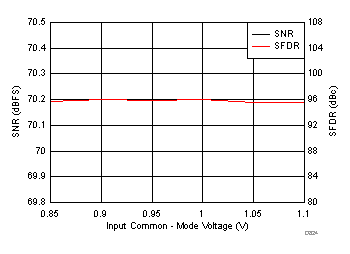

AVDD Supply and Temperature

DVDD Supply and Temperature

(150 MHz)

(150 MHz)
7.18 Typical Characteristics: Common Plots
Typical values are at TA = 25°C, ADC sampling rate = 160 MSPS, 50% clock duty cycle, AVDD = DVDD = 1.8 V, –1-dBFS differential input, 2-VPP full-scale, and 32k-point FFT, unless otherwise noted.
| fS = 160 MSPS, fCM = 10 MHz, 50 mVPP, fIN = 30 MHz, Amplitude (fIN + fCM ) = –98 dBFS, Amplitude (fIN – fCM ) = –91 dBFS |

| fS = 160 MSPS, fPSRR = 5 MHz, 50 mVPP, fIN = 30 MHz, Amplitude (fIN + fPSRR ) = –65 dBFS, Amplitude (fIN – fPSRR ) = –67 dBFS |

(20X Mode)
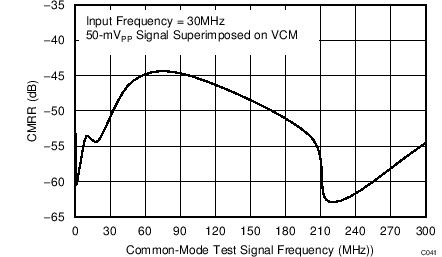


(40X Mode)
7.19 Typical Characteristics: Contour Plots
Typical values are at TA = 25°C, 50% clock duty cycle, AVDD = DVDD = 1.8 V, –1-dBFS differential input, 2-VPP full-scale, and 32k-point FFT, unless otherwise noted.
for 0-dB Gain

for 0-dB Gain
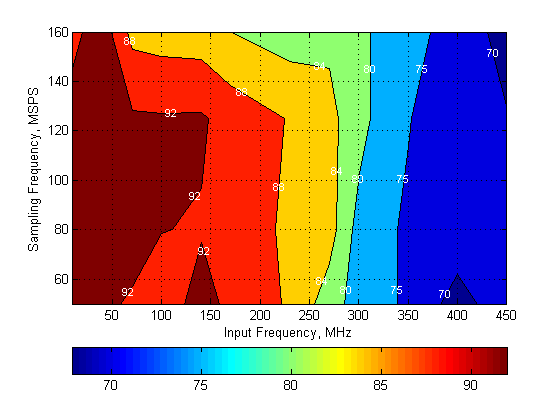
for 6-dB Gain
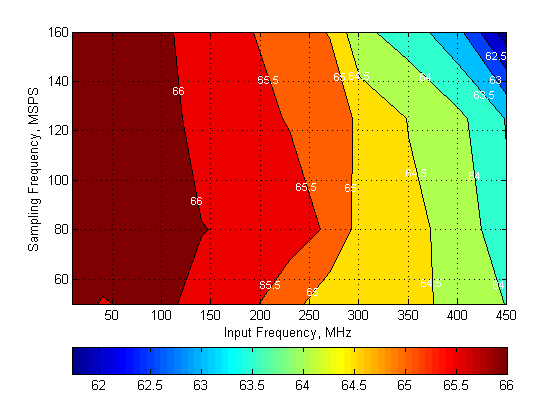
for 6-dB Gain
8 Parameter Measurement Information
8.1 Timing Diagrams



 Figure 146. SYSREF Timing (Subclass 1)
Figure 146. SYSREF Timing (Subclass 1)
 Figure 147. SYNC~ Timing (Subclass 2)
Figure 147. SYNC~ Timing (Subclass 2)
9 Detailed Description
9.1 Overview
The ADC32J2x are a high-linearity, ultra-low power, dual-channel, 12-bit, 50-MSPS to 160-MSPS, analog-to-digital converter (ADC) family. The devices are designed specifically to support demanding, high input frequency signals with large dynamic range requirements. A clock input divider allows more flexibility for system clock architecture design and the SYSREF input enables complete system synchronization. The devices support a JESD204B interface in order to reduce the number of interface lines, thus allowing for high system integration density. The JESD204B interface is a serial interface, where the data of each ADC are serialized and output over only one differential pair. An internal phase-locked loop (PLL) multiplies the incoming ADC sampling clock by 20 to derive the bit clock that is used to serialize the 12-bit data from each channel. The devices support subclass 0, 1, 2 with interface data rates up to 3.2 Gbps.
9.2 Functional Block Diagram

9.3 Feature Description
9.3.1 Analog Inputs
The ADC32J2x analog signal inputs are designed to be driven differentially. Each input pin (INP, INM) must swing symmetrically between (VCM + 0.5 V) and (VCM – 0.5 V), resulting in a 2-VPP (default) differential input swing. The input sampling circuit has a 3-dB bandwidth that extends up to 450 MHz (50-Ω source driving 50-Ω termination between INP and INM).
9.3.2 Clock Input
The device clock inputs can be driven differentially (sine, LVPECL, or LVDS) or single-ended (LVCMOS), with little or no difference in performance between them. The common-mode voltage of the clock inputs is set to 1.4 V using internal 5-kΩ resistors. The self-bias clock inputs of the ADC32J2x can be driven by the transformer-coupled, sine-wave clock source or by the ac-coupled, LVPECL and LVDS clock sources, as shown in Figure 148, Figure 149, and Figure 150. See Figure 151 for details regarding the internal clock buffer.

 Figure 149. LVDS Clock Driving Circuit
Figure 149. LVDS Clock Driving Circuit
 Figure 150. LVPECL Clock Driving Circuit
Figure 150. LVPECL Clock Driving Circuit

A single-ended CMOS clock can be ac-coupled to the CLKP input, with CLKM connected to ground with a 0.1-μF capacitor, as shown in Figure 152. However, for best performance the clock inputs must be driven differentially, thereby reducing susceptibility to common-mode noise. For high input frequency sampling, a clock source with very low jitter is recommended. Band-pass filtering of the clock source can help reduce the effects of jitter. There is no change in performance with a non-50% duty cycle clock input.
 Figure 152. Single-Ended Clock Driving Circuit
Figure 152. Single-Ended Clock Driving Circuit
9.3.2.1 SNR and Clock Jitter
The signal-to-noise ratio of the ADC is limited by three different factors: quantization noise, thermal noise, and jitter noise, as shown in Equation 1. Quantization noise is typically not noticeable in pipeline converters and is 74 dB for a 12-bit ADC. Thermal noise limits SNR at low input frequencies and clock jitter sets SNR for higher input frequencies.

The SNR limitation resulting from sample clock jitter can be calculated with Equation 2:

The total clock jitter (TJitter) has two components: the internal aperture jitter (200 fs for the device) that is set by the noise of the clock input buffer and the external clock. TJitter can be calculated with Equation 3:

External clock jitter can be minimized by using high-quality clock sources and jitter cleaners as well as band-pass filters at the clock input and a faster clock slew rate improves the ADC aperture jitter. The devices have a thermal noise of 73.5 dBFS and internal aperture jitter of 200 fs. The SNR, depending on the amount of external jitter for different input frequencies, is shown in Figure 153.
 Figure 153. SNR vs Frequency and Jitter
Figure 153. SNR vs Frequency and Jitter
9.3.2.2 Input Clock Divider
The devices are equipped with an internal divider on the clock input. The divider allows operation with a faster input clock, thus simplifying the system clock distribution design. The clock divider can be bypassed (divide-by-1) for operation with a 160-MHz clock, the divide-by-2 option supports a maximum input clock of 320 MHz, and the divide-by-4 option supports a maximum input clock frequency of 640 MHz.
9.3.3 Power-Down Control
The power-down functions of the ADC32J2x can be controlled either through the parallel control pin (PDN) or through an SPI register setting (see register 15h). The PDN pin can also be configured via SPI to a global power-down or standby functionality.
Table 2. Power-Down Modes
| FUNCTION | POWER CONSUMPTION (mW) | WAKE-UP TIME (µs) |
|---|---|---|
| Global power-down | 5 | 85 |
| Standby | 118 | 35 |
9.3.4 Internal Dither Algorithm
The ADC32J2x uses an internal dither algorithm to achieve high SFDR and a clean spectrum. However, the dither algorithm marginally degrades SNR, creating a trade-off between SNR and SFDR. If desired, the dither algorithm can be turned off by using the DIS DITH CHx registers bits. Figure 154 and Figure 155 show the effect of using dither algorithms.

| fS = 160 MSPS, SNR = 69.8 dBFS, fIN = 70 MHz, SFDR = 88.1 dBc |

| fS = 160 MSPS, SNR = 70.1 dBFS, fIN = 70 MHz, SFDR = 85.4 dBc |
9.3.5 JESD204B Interface
The ADC32J2x support device subclass 0, 1, and 2 with a maximum output data rate of 3.2 Gbps for each serial transmitter, as shown in Figure 156. The data of each ADC are serialized by 20X using an internal PLL and then transmitted out on one differential pair each. An external SYSREF (subclass 1) or SYNC (subclass 2) signal is used to align all internal clock phases and the local multiframe clock to a specific sampling clock edge. This process allows synchronization of multiple devices in a system and minimizes timing and alignment uncertainty.
 Figure 156. JESD204B Interface
Figure 156. JESD204B Interface
The JESD204B transmitter block consists of the transport layer, the data scrambler, and the link layer, as shown in Figure 157. The transport layer maps the ADC output data into the selected JESD204B frame data format and determines if the ADC output data or test patterns are transmitted. The link layer performs the 8b or 10b data encoding and the synchronization and initial lane alignment using the SYNC input signal. Optionally, data from the transport layer can be scrambled.
 Figure 157. JESD204B Block
Figure 157. JESD204B Block
9.3.5.1 JESD204B Initial Lane Alignment (ILA)
The initial lane alignment process is started by the receiving device by asserting the SYNC signal. When a logic high is detected on the SYNC input pins, the ADC32J2x starts transmitting comma (K28.5) characters to establish code group synchronization. When synchronization is complete, the receiving device de-asserts the SYNC signal and the ADC32J2x starts the initial lane alignment sequence with the next local multiframe clock boundary. The ADC32J2x transmits four multiframes, each containing K frames (K is SPI programmable). Each multiframe contains the frame start and end symbols; the second multiframe also contains the JESD204 link configuration data.
9.3.5.2 JESD204B Test Patterns
There are three different test patterns available in the transport layer of the JESD204B interface. The ADC32J2x supports a clock output, an encoded, and a PRBS (215 – 1) pattern. These patterns can be enabled via SPI register writes and are located in address 26h (bits 7:6).
9.3.5.3 JESD204B Frame Assembly
The JESD204B standard defines the following parameters:
- L is the number of lanes per link,
- M is the number of converters per device,
- F is the number of octets per frame clock period, and
- S is the number of samples per frame.
Table 3. LMFS Values and Interface Rate
| L | M | F | S | MINIMUM ADC SAMPLING RATE (MSPS) | MAXIMUM fSERDES (Mbps) | MAXIMUM ADC SAMPLING RATE (Msps) | MAXIMUM fSERDES (GSPS) | MODE |
|---|---|---|---|---|---|---|---|---|
| 2 | 2 | 2 | 1 | 15 | 300 | 160 | 3.2 | 20X (default) |
| 1 | 2 | 4 | 1 | 10 | 400 | 80 | 3.2 | 40X |
The detailed frame assembly for quad-channel mode is shown in Figure 158. The frame assembly configuration can be changed from 20X (default) to 40X by setting the registers listed in Table 4.
 Figure 158. JESD Frame Assembly
Figure 158. JESD Frame Assembly
Table 4. Configuring 40X Mode
| ADDRESS | DATA |
|---|---|
| 2Bh | 01h |
| 30h | 11h |
9.3.5.4 Digital Outputs
The ADC32J2x JESD204B transmitter uses differential CML output drivers. The CML output current is programmable from 5 mA to 20 mA using SPI register settings. The output driver expects to drive a differential 100-Ω load impedance and place the termination resistors as close to the receiver inputs as possible to avoid unwanted reflections and signal distortion. Because the JESD204B employs 8b, 10b encoding, the output data stream is dc-balanced and ac-coupling can be used to avoid the need to match up common-mode voltages between the transmitter and receivers. Connect the termination resistors to the termination voltage, as shown in Figure 159.
 Figure 159. CML Output Connections
Figure 159. CML Output Connections
Figure 160 shows the data eye measurements of the device JESD204B transmitter against the JESD204B transmitter mask at 3.125 Gbps (156.25 MSPS, 20X mode), respectively.
 Figure 160. Eye Diagram: 3.125 Gbps
Figure 160. Eye Diagram: 3.125 Gbps
9.4 Device Functional Modes
9.4.1 Digital Gain
The input full-scale amplitude can be selected between 1 VPP to 2 VPP (default is 2 VPP) by choosing the appropriate digital gain setting via an SPI register write. Digital gain provides an option to trade-off SNR for SFDR performance. A larger input full-scale increases SNR performance (2 VPP is recommended for maximum SNR) whereas reduced input swing typically results in better SFDR performance. Table 5 lists the available digital gain settings.
Table 5. Digital Gain vs Full-Scale Amplitude
| DIGITAL GAIN (dB) | MAX INPUT VOLTAGE (VPP) |
|---|---|
| 0 | 2.0 |
| 0.5 | 1.89 |
| 1 | 1.78 |
| 1.5 | 1.68 |
| 2 | 1.59 |
| 2.5 | 1.50 |
| 3 | 1.42 |
| 3.5 | 1.34 |
| 4 | 1.26 |
| 4.5 | 1.19 |
| 5 | 1.12 |
| 5.5 | 1.06 |
| 6 | 1.00 |
9.4.2 Overrange Indication
The ADC32J2x provides two different overrange indications. The normal OVR (default) is triggered if the final 12-bit data output exceeds the maximum code value. The fast OVR is triggered if the input voltage exceeds the programmable overrange threshold and is presented after just nine clock cycles, thus enabling a quicker reaction to an overrange event. By default, the normal overrange indication is output on the OVRx pins (where x is A, B, C, or D). The fast OVR indication can be presented on the overrange pins instead by using the SPI register map.
9.5 Programming
The ADC32J2x can be configured using a serial programming interface, as described in this section.
9.5.1 Serial Interface
The device has a set of internal registers that can be accessed by the serial interface formed by the SEN (serial interface enable), SCLK (serial interface clock), SDATA (serial interface data), and SDOUT (serial interface data output) pins. Serially shifting bits into the device is enabled when SEN is low. Serial data SDATA are latched at every SCLK rising edge when SEN is active (low). The serial data are loaded into the register at every 24th SCLK rising edge when SEN is low. When the word length exceeds a multiple of 24 bits, the excess bits are ignored. Data can be loaded in multiples of 24-bit words within a single active SEN pulse. The interface can function with SCLK frequencies from 20 MHz down to very low speeds (of a few hertz) and also with a non-50% SCLK duty cycle.
9.5.1.1 Register Initialization
After power-up, the internal registers must be initialized to their default values through a hardware reset by applying a high pulse on the RESET pin (of durations greater than 10 ns); see Figure 161. If required, the serial interface registers can be cleared during operation either:
- Through a hardware reset, or
- By applying a software reset. When using the serial interface, set the RESET bit (D0 in register address 06h) high. This setting initializes the internal registers to the default values and then self-resets the RESET bit low. In this case, the RESET pin is kept low.
9.5.1.1.1 Serial Register Write
The device internal register can be programmed with these steps:
- Drive the SEN pin low,
- Set the R/W bit to 0 (bit A15 of the 16-bit address),
- Set bit A14 in the address field to 1,
- Initiate a serial interface cycle by specifying the address of the register (A13 to A0) whose content must be written, and
- Write the 8-bit data that are latched in on the SCLK rising edge.
Figure 161 and Table 6 show the timing requirements for the serial register write operation.
 Figure 161. Serial Register Write Timing Diagram
Figure 161. Serial Register Write Timing Diagram
Table 6. Serial Interface Timing(1)
| MIN | TYP | MAX | UNIT | ||
|---|---|---|---|---|---|
| fSCLK | SCLK frequency (equal to 1 / tSCLK) | > dc | 20 | MHz | |
| tSLOADS | SEN to SCLK setup time | 25 | ns | ||
| tSLOADH | SCLK to SEN hold time | 25 | ns | ||
| tDSU | SDIO setup time | 25 | ns | ||
| tDH | SDIO hold time | 25 | ns | ||
9.5.1.1.2 Serial Register Readout
The device includes a mode where the contents of the internal registers can be read back using the SDOUT pin. This readback mode may be useful as a diagnostic check to verify the serial interface communication between the external controller and the ADC. Given below is the procedure to read contents of serial registers:
- Drive the SEN pin low.
- Set the R/W bit (A15) to 1. This setting disables any further writes to the registers.
- Set bit A14 in the address field to 1.
- Initiate a serial interface cycle specifying the address of the register (A13 to A0) whose content must be read.
- The device outputs the contents (D7 to D0) of the selected register on the SDOUT pin.
- The external controller can latch the contents at the SCLK rising edge.
- To enable register writes, reset the R/W register bit to 0.
When READOUT is disabled, the SDOUT pin is in a high-impedance mode. If serial readout is not used, the SDOUT pin must float. Figure 162 shows a timing diagram of the serial register read operation. Data appear on the SDOUT pin at the SCLK falling edge with an approximate delay (tSD_DELAY) of 20 ns, as shown in Figure 163.
 Figure 162. Serial Register Read Timing Diagram
Figure 162. Serial Register Read Timing Diagram
 Figure 163. SDOUT Timing Diagram
Figure 163. SDOUT Timing Diagram
9.5.2 Register Initialization
After power-up, the internal registers must be initialized to their default values through a hardware reset by applying a high pulse on the RESET pin, as shown in Figure 164 and Table 7.
 Figure 164. Initialization of Serial Registers after Power-Up
Figure 164. Initialization of Serial Registers after Power-Up
Table 7. Power-Up Timing
| MIN | TYP | MAX | UNIT | |||
|---|---|---|---|---|---|---|
| t1 | Power-on delay from power up to active high RESET pulse | 1 | ms | |||
| t2 | Reset pulse duration: active high RESET pulse duration | 10 | 1000 | ns | ||
| t3 | Register write delay from RESET disable to SEN active | 100 | ns | |||
If required, the serial interface registers can be cleared during operation either:
- Through hardware reset, or
- By applying a software reset. When using the serial interface, set the RESET bit (D0 in register address 06h) high. This setting initializes the internal registers to the default values and then self-resets the RESET bit low. In this case, the RESET pin is kept low.
9.5.3 Start-Up Sequence
After power-up, the sequence described in Table 8 can be used to set up the ADC32J2x for basic operation.
Table 8. Start-Up Settings
| STEP | DESCRIPTION | REGISTER ADDRESS AND DATA |
|---|---|---|
| 1 | Supply all supply voltages. There is no required power supply sequence for AVDD and DVDD | — |
| 2 | Pulse hardware reset (low to high to low) on pin 24 | — |
| 3 | Optional configure LMFS of JESD204B interface to LMFS = 1241 (default is LMFS = 2221) | Address 2Bh, data 01h Address 30h, data 11h |
| 4 | Pulse SYNCb from low to high to transmit data from k28.5 sync mode | — |
9.6 Register Maps
Table 9. Register Map Summary
| REGISTER ADDRESS (A[13:0], Hex) |
REGISTER DATA | |||||||
|---|---|---|---|---|---|---|---|---|
| 7 | 6 | 5 | 4 | 3 | 2 | 1 | 0 | |
| 01 | 0 | 0 | DIS DITHER CHA | DIS DITHER CHB | 0 | 0 | ||
| 03 | 0 | 0 | 0 | 0 | 0 | 0 | CHA GAINEN | 0 |
| 04 | 0 | 0 | 0 | 0 | 0 | 0 | CHB GAINEN | 0 |
| 06 | 0 | 0 | 0 | 0 | 0 | 0 | TEST PATTERN EN | RESET |
| 07 | 0 | 0 | 0 | SPECIAL MODE1 CHA | EN FOVR | 0 | ||
| 08 | 0 | 0 | 0 | SPECIAL MODE1 CHB | 0 | 0 | ||
| 09 | 0 | 0 | 0 | 0 | 0 | 0 | ALIGN TEST PATTERN | DATA FORMAT |
| 0A | 0 | 0 | 0 | 0 | CHA TEST PATTERN | |||
| 0B | CHB TEST PATTERN | 0 | 0 | 0 | 0 | |||
| 0C | 0 | 0 | 0 | 0 | CHA DIGITAL GAIN | |||
| 0D | CHB DIGITAL GAIN | 0 | 0 | 0 | 0 | |||
| 0E | CUSTOM PATTERN [11:4] | |||||||
| 0F | CUSTOM PATTERN [3:0] | 0 | 0 | 0 | ||||
| 13 | LOW SPEED MODE | 0 | 0 | 0 | 0 | 0 | 0 | 0 |
| 15 | 0 | CHA PDN | CHB PDN | 0 | STANDBY | GLOBAL PDN | 0 | CONFIG PDN PIN |
| 27 | CLK DIV | 0 | 0 | 0 | 0 | 0 | 0 | |
| 2A | SERDES TEST PATTERN | IDLE SYNC | TRP LAYER TESTMODE EN |
FLIP ADC DATA |
LANE ALIGN |
FRAME ALIGN | TXMIT LINKDATA DIS |
|
| 2B | 0 | 0 | 0 | 0 | 0 | 0 | CTRL K | CTRL F |
| 2F | SCRAMBLE EN | 0 | 0 | 0 | 0 | 0 | 0 | 0 |
| 30 | OCTETS PER FRAME | |||||||
| 31 | 0 | 0 | 0 | FRAMES PER MULTIFRAME | ||||
| 34 | SUBCLASSV | 0 | 0 | 0 | 0 | 0 | ||
| 3A | SYNC REG | SYNC REQ EN | 0 | 0 | OUTPUT CURRENT SEL | |||
| 3B | LINK LAYER TESTMODE SEL [2:0] | LINK LAYER RPAT | 0 | PULSE DET MODES | ||||
| 3C | FORCE LMFC COUNT | LMFC COUNT INIT | RELEASE ILANE SEQ | |||||
| 422 | 0 | 0 | 0 | 0 | 0 | 0 | SPECIAL MODE2 CHA |
0 |
| 434 | 0 | 0 | DIS DITH CHA | 0 | DIS DITH CHA | 0 | 0 | 0 |
| 522 | 0 | 0 | 0 | 0 | 0 | 0 | SPECIAL MODE2 CHB |
0 |
| 534 | 0 | 0 | DIS DITH CHB | 0 | DIS DITH CHB | 0 | 0 | 0 |
9.6.1 Summary of Special Mode Registers
Table 10 lists the location, value, and functions of special mode registers in the device.
Table 10. Special Modes Summary
| MODE | LOCATION | VALUE AND FUNCTION | |
|---|---|---|---|
| Dither mode | DIS DITH CHA | 01h (bits 5-4), 434h (bits 5, 3) | Creates a noise floor cleaner and improves SFDR; see the Internal Dither Algorithm section. 0000 = Dither disabled 1111 = Dither enabled |
| DIS DITH CHB | 01h (bits 3-2), 534h (bits 5, 3) | ||
| Special mode 1 | SPECIAL MODE 1 CHA | 07h (bits 4-2) | Use for improved HD3. 000 = Default after reset 010 = Use for frequency < 120 MHz 111 = Use for frequency > 120 MHz |
| SPECIAL MODE 1 CHB | 08h (bits 4-2) | ||
| Special mode 2 | SPECIAL MODE 2 CHA | 422h (bits 1-0) | Helps improve HD2. 00 = Default after reset 11 = Improves HD2 |
| SPECIAL MODE 2 CHB | 522h (bits 1-0) | ||
9.6.2 Serial Register Descriptions
9.6.2.1 Register 01h (address = 01h)
| 7 | 6 | 5 | 4 | 3 | 2 | 1 | 0 |
| 0 | 0 | DIS DITHER CHA | DIS DITHER CHB | 0 | 0 | ||
| W-0h | W-0h | R/W-0h | R/W-0h | W-0h | W-0h | ||
| LEGEND: R/W = Read/Write; W = Write only; -n = value after reset |
Table 11. Register 01h Field Descriptions
| Bit | Field | Type | Reset | Description |
|---|---|---|---|---|
| 7-6 | 0 | W | 0h | Must write 0 |
| 5-4 | DIS DITHER CHA | R/W | 0h | These bits enable or disables the on-chip dither. Control these bits with bits 5 and 3 of register 434h. 00 = Dither enabled 11 = Dither disabled. Improves SNR by 0.2 dB for input frequencies up to 170 MHz. |
| 3-2 | DIS DITHER CHB | R/W | 0h | These bits enable or disables the on-chip dither. Control these bits with bits 5 and 3 of register 534h. 00 = Dither enabled 11 = Dither disabled. Improves SNR by 0.2 dB for input frequencies up to 170 MHz. |
| 1-0 | 0 | W | 0h | Must write 0 |
9.6.2.2 Register 03h (address = 03h)
| 7 | 6 | 5 | 4 | 3 | 2 | 1 | 0 |
| 0 | 0 | 0 | 0 | 0 | 0 | CHA GAINEN | 0 |
| W-0h | W-0h | W-0h | W-0h | W-0h | W-0h | R/W-0h | W-0h |
| LEGEND: R/W = Read/Write; W = Write only; -n = value after reset |
Table 12. Register 03h Field Descriptions
| Bit | Field | Type | Reset | Description |
|---|---|---|---|---|
| 7-2 | 0 | W | 0h | Must write 0 |
| 1 | CHA GAINEN | R/W | 0h | Digital gain enable bit for channel A. 0 = Digital gain disabled 1 = Digital gain enabled |
| 0 | 0 | W | 0h | Must write 0 |
9.6.2.3 Register 04h (address = 04h)
| 7 | 6 | 5 | 4 | 3 | 2 | 1 | 0 |
| 0 | 0 | 0 | 0 | 0 | 0 | CHB GAINEN | 0 |
| W-0h | W-0h | W-0h | W-0h | W-0h | W-0h | R/W-0h | W-0h |
| LEGEND: R/W = Read/Write; W = Write only; -n = value after reset |
Table 13. Register 04h Field Descriptions
| Bit | Field | Type | Reset | Description |
|---|---|---|---|---|
| 7-2 | 0 | W | 0h | Must write 0 |
| 1 | CHB GAINEN | R/W | 0h | Digital gain enable bit for channel B. 0 = Digital gain disabled 1 = Digital gain enabled |
| 0 | 0 | W | 0h | Must write 0 |
9.6.2.4 Register 06h (address = 06h)
| 7 | 6 | 5 | 4 | 3 | 2 | 1 | 0 |
| 0 | 0 | 0 | 0 | 0 | 0 | TEST PATTERN EN | RESET |
| W-0h | W-0h | W-0h | W-0h | W-0h | W-0h | R/W-0h | R/W-0h |
| LEGEND: R/W = Read/Write; W = Write only; -n = value after reset |
Table 14. Register 06h Field Descriptions
| Bit | Field | Type | Reset | Description |
|---|---|---|---|---|
| 7-2 | 0 | W | 0h | Must write 0 |
| 1 | TEST PATTERN EN | R/W | 0h | This bit enables the test pattern selection for the digital outputs. 0 = Normal operation 1 = Test pattern output enabled |
| 0 | RESET | R/W | 0h | Software reset applied. This bit resets all internal registers to the default values and self-clears to 0. |
9.6.2.5 Register 07h (address = 07h)
| 7 | 6 | 5 | 4 | 3 | 2 | 1 | 0 |
| 0 | 0 | 0 | SPECIAL MODE1 CHA | EN FOVR | 0 | ||
| W-0h | W-0h | W-0h | R/W-0h | R/W-0h | W-0h | ||
| LEGEND: R/W = Read/Write; W = Write only; -n = value after reset |
Table 15. Register 07h Field Descriptions
| Bit | Field | Type | Reset | Description |
|---|---|---|---|---|
| 7-5 | 0 | W | 0h | Must write 0 |
| 4-2 | SPECIAL MODE1 CHA | R/W | 0h | 010 = For frequencies < 120 MHz 111 = For frequencies > 120 MHz |
| 1 | EN FOVR | R/W | 0h | 0 = Normal OVR on OVRx pins 1 = Enable fast OVR on OVRx pins |
| 0 | 0 | W | 0h | Must write 0 |
9.6.2.6 Register 08h (address = 08h)
| 7 | 6 | 5 | 4 | 3 | 2 | 1 | 0 |
| 0 | 0 | 0 | SPECIAL MODE1 CHB | 0 | 0 | ||
| W-0h | W-0h | W-0h | R/W-0h | R/W-0h | W-0h | ||
| LEGEND: R/W = Read/Write; W = Write only; -n = value after reset |
Table 16. Register 08h Field Descriptions
| Bit | Field | Type | Reset | Description |
|---|---|---|---|---|
| 7-5 | 0 | W | 0h | Must write 0 |
| 4-2 | SPECIAL MODE1 CHB | R/W | 0h | 010 = For frequencies < 120 MHz 111 = For frequencies > 120 MHz |
| 1-0 | 0 | W | 0h | Must write 0 |
9.6.2.7 Register 09h (address = 09h)
| 7 | 6 | 5 | 4 | 3 | 2 | 1 | 0 |
| 0 | 0 | 0 | 0 | 0 | 0 | ALIGN TEST PATTERN | DATA FORMAT |
| W-0h | W-0h | W-0h | W-0h | W-0h | W-0h | R/W-0h | R/W-0h |
| LEGEND: R/W = Read/Write; W = Write only; -n = value after reset |
Table 17. Register 09h Field Descriptions
| Bit | Field | Type | Reset | Description |
|---|---|---|---|---|
| 7-2 | 0 | W | 0h | Must write 0 |
| 1 | ALIGN TEST PATTERN | R/W | 0h | This bit aligns test patterns across the outputs of the four channels. 0 = Test patterns of four channels are free running 1 = Test patterns of all 4 channels are aligned |
| 0 | DATA FORMAT | R/W | 0h | This bit sets the digital output data format. 0 = Twos complement 1 = Offset binary |
9.6.2.8 Register 0Ah (address = 0Ah)
| 7 | 6 | 5 | 4 | 3 | 2 | 1 | 0 |
| 0 | 0 | 0 | 0 | CHA TEST PATTERN | |||
| W-0h | W-0h | W-0h | W-0h | R/W-0h | |||
| LEGEND: R/W = Read/Write; W = Write only; -n = value after reset |
Table 18. Register 0Ah Field Descriptions
| Bit | Field | Type | Reset | Description |
|---|---|---|---|---|
| 7-4 | 0 | W | 0h | Must write 0 |
| 3-0 | CHA TEST PATTERN | R/W | 0h | These bits control the test pattern for channel A after the TEST PATTERN EN bit is set. 0000 = Normal operation 0001 = All 0's 0010 = All 1's 0011 = Toggle pattern: data alternate between 10101010101010 and 01010101010101. 0100 = Digital ramp: data increments by 1 LSB every clock cycle from code 0 to 4095. 0101 = Custom pattern: output data are the same as programmed by the CUSTOM PATTERN register bits. 0110 = Deskew pattern: data are AAAh. 1000 = PRBS pattern: data are a sequence of pseudo random numbers. 1001 = 8-point sine-wave: data are a repetitive sequence of the following eight numbers that form a sine-wave: 0, 599, 2048, 3496, 4095, 3496, 2048, 599. Others = Do not use |
9.6.2.9 Register 0Bh (address = 0Bh)
| 7 | 6 | 5 | 4 | 3 | 2 | 1 | 0 |
| CHB TEST PATTERN | 0 | 0 | 0 | 0 | |||
| R/W-0h | W-0h | W-0h | W-0h | W-0h | |||
| LEGEND: R/W = Read/Write; W = Write only; -n = value after reset |
Table 19. Register 0Bh Field Descriptions
| Bit | Field | Type | Reset | Description |
|---|---|---|---|---|
| 7-4 | CHB TEST PATTERN | R/W | 0h | These bits control the test pattern for channel B after the TEST PATTERN EN bit is set. 0000 = Normal operation 0001 = All 0's 0010 = All 1's 0011 = Toggle pattern: data alternate between 10101010101010 and 01010101010101. 0100 = Digital ramp: data increment by 1 LSB every clock cycle from code 0 to 4095. 0101 = Custom pattern: output data are the same as programmed by the CUSTOM PATTERN register bits. 0110 = Deskew pattern: data are AAAh. 1000 = PRBS pattern: data are a sequence of pseudo random numbers. 1001 = 8-point sine-wave: data are a repetitive sequence of the following eight numbers that form a sine-wave: 0, 599, 2048, 3496, 4095, 3496, 2048, 599. Others = Do not use |
| 3-0 | 0 | W | 0h | Must write 0 |
9.6.2.10 Register 0Ch (address = 0Ch)
| 7 | 6 | 5 | 4 | 3 | 2 | 1 | 0 |
| 0 | 0 | 0 | 0 | CHA DIGITAL GAIN | |||
| W-0h | W-0h | W-0h | W-0h | R/W-0h | |||
| LEGEND: R/W = Read/Write; W = Write only; -n = value after reset |
Table 20. Register 0Ch Field Descriptions
| Bit | Field | Type | Reset | Description |
|---|---|---|---|---|
| 7-4 | 0 | W | 0h | Must write 0 |
| 3-0 | CHA DIGITAL GAIN | R/W | 0h | These bits set the digital gain for individual channels. For register settings see Table 21. |
Table 21. Channel Digital Gain
| REGISTER VALUE | DIGITAL GAIN (dB) | MAXIMUM INPUT VOLTAGE (VPP) |
|---|---|---|
| 0000 | 0 | 2.0 |
| 0001 | 0.5 | 1.89 |
| 0010 | 1 | 1.78 |
| 0011 | 1.5 | 1.68 |
| 0100 | 2 | 1.59 |
| 0101 | 2.5 | 1.50 |
| 0110 | 3 | 1.42 |
| 0111 | 3.5 | 1.34 |
| 1000 | 4 | 1.26 |
| 1001 | 4.5 | 1.19 |
| 1010 | 5 | 1.12 |
| 1011 | 5.5 | 1.06 |
| 1100 | 6 | 1.00 |
9.6.2.11 Register 0Dh (address = 0Dh)
| 7 | 6 | 5 | 4 | 3 | 2 | 1 | 0 |
| CHB DIGITAL GAIN | 0 | 0 | 0 | 0 | |||
| R/W-0h | W-0h | W-0h | W-0h | W-0h | |||
| LEGEND: R/W = Read/Write; W = Write only; -n = value after reset |
Table 22. Register 0Dh Field Descriptions
| Bit | Field | Type | Reset | Description |
|---|---|---|---|---|
| 7-4 | CHB DIGITAL GAIN | R/W | 0h | These bits set the digital gain for the individual channels. For register settings see Table 21. |
| 3-0 | 0 | W | 0h | Must write 0 |
9.6.2.12 Register 0Eh (address = 0Eh)
| 7 | 6 | 5 | 4 | 3 | 2 | 1 | 0 |
| CUSTOM PATTERN[11:4] | |||||||
| R/W-0h | |||||||
| LEGEND: R/W = Read/Write; -n = value after reset |
Table 23. Register 0Eh Field Descriptions
| Bit | Field | Type | Reset | Description |
|---|---|---|---|---|
| 7-0 | CUSTOM PATTERN[11:4] | R/W | 0h | These bits set the custom pattern[11:4] for all channels. |
9.6.2.13 Register 0Fh (address = 0Fh)
| 7 | 6 | 5 | 4 | 3 | 2 | 1 | 0 |
| CUSTOM PATTERN[3:0] | 0 | 0 | |||||
| R/W-0h | W-0h | W-0h | |||||
| LEGEND: R/W = Read/Write; W = Write only; -n = value after reset |
Table 24. Register 0Fh Field Descriptions
| Bit | Field | Type | Reset | Description |
|---|---|---|---|---|
| 7-2 | CUSTOM PATTERN[3:0] | R/W | 0h | These bits set the custom pattern[3:0] for all channels. |
| 1-0 | 0 | W | 0h | Must write 0 |
9.6.2.14 Register 13h (address = 13h)
| 7 | 6 | 5 | 4 | 3 | 2 | 1 | 0 |
| LOW SPEED MODE | 0 | 0 | 0 | 0 | 0 | 0 | 0 |
| R/W-0h | W-0h | W-0h | W-0h | W-0h | W-0h | W-0h | W-0h |
| LEGEND: R/W = Read/Write; W = Write only; -n = value after reset |
Table 25. Register 13h Field Descriptions
| Bit | Field | Type | Reset | Description |
|---|---|---|---|---|
| 7 | LOW SPEED MODE | R/W | 0h | Use this bit for sampling frequencies < 25 MSPS. 0 = Normal operation 1 = Low-speed mode is enabled |
| 6-0 | 0 | W | 0h | Must write 0 |
9.6.2.15 Register 15h (address = 15h)
| 7 | 6 | 5 | 4 | 3 | 2 | 1 | 0 |
| 0 | CHA PDN | CHB PDN | 0 | STANDBY | GLOBAL PDN |
0 | PDN PIN DISABLE |
| W-0h | R/W-0h | R/W-0h | W-0h | R/W-0h | R/W-0h | W-0h | R/W-0h |
| LEGEND: R/W = Read/Write; W = Write only; -n = value after reset |
Table 26. Register 15h Field Descriptions
| Bit | Field | Type | Reset | Description |
|---|---|---|---|---|
| 7 | 0 | W | 0h | Must write 0 |
| 6 | CHA PDN | R/W | 0h | Power-down channel A. 0 = Normal operation 1 = Power-down channel A if PDN PIN DISABLE register bit is set |
| 5 | CHB PDN | R/W | 0h | Power-down channel B. 0 = Normal operation 1 = Power-down channel B if PDN PIN DISABLE register bit is set |
| 4 | 0 | W | 0h | Must write 0 |
| 3 | STANDBY | R/W | 0h | ADCs of both channels enter standby. 0 = Normal operation 1 = Standby |
| 2 | GLOBAL PDN | R/W | 0h | Global power-down. 0 = Normal operation 1 = Global power-down |
| 1 | 0 | W | 0h | Must write 0 |
| 0 | PDN PIN DISABLE | R/W | 0h | This bit disables the power-down control from the pin. 0 = Normal operation 1 = Power-down pin is disabled, use register settings for power-down operations |
9.6.2.16 Register 27h (address = 27h)
| 7 | 6 | 5 | 4 | 3 | 2 | 1 | 0 |
| CLK DIV | 0 | 0 | 0 | 0 | 0 | 0 | |
| R/W-0h | W-0h | W-0h | W-0h | W-0h | W-0h | W-0h | |
| LEGEND: R/W = Read/Write; W = Write only; -n = value after reset |
Table 27. Register 27h Field Descriptions
| Bit | Field | Type | Reset | Description |
|---|---|---|---|---|
| 7-6 | CLK DIV | R/W | 0h | Internal clock divider for the input sample clock. 00 = Clock divider bypassed 01 = Divide-by-1 10 = Divide-by-2 11 = Divide-by-4 |
| 5-0 | 0 | W | 0h | Must write 0 |
9.6.2.17 Register 2Ah (address = 2Ah)
| 7 | 6 | 5 | 4 | 3 | 2 | 1 | 0 |
| SERDES TEST PATTERN | IDLE SYNC | TRP LAYER TESTMODE EN | FLIP ADC DATA | LANE ALIGN | FRAME ALIGN | TX LINK CONFIG DATA DIS | |
| R/W-0h | R/W-0h | R/W-0h | R/W-0h | R/W-0h | R/W-0h | R/W-0h | |
| LEGEND: R/W = Read/Write; -n = value after reset |
Table 28. Register 2Ah Field Descriptions
| Bit | Field | Type | Reset | Description |
|---|---|---|---|---|
| 7-6 | SERDES TEST PATTERN | R/W | 0h | 00 = Normal operation 01 = Outputs clock pattern: output is 10101010 pattern 10 = Encoded pattern: output is 1111111100000000 11 = PRBS sequence: output is 215 – 1 |
| 5 | IDLE SYNC | R/W | 0h | This bit sets the output pattern when SYNC is high. 0 = Sync code is k28.5 (BCBCh) 1 = Sync code is BC50h |
| 4 | TRP LAYER TESTMODE EN | R/W | 0h | This bit generates the long transport layer test pattern mode according to 5.1.6.3 clause of the JESD204B specification. 0 = Test mode disabled 1 = Test mode enabled |
| 3 | FLIP ADC DATA | R/W | 0h | 0 = Normal operation 1 = Output data order is reversed: MSB – LSB |
| 2 | LANE ALIGN | R/W | 0h | This bit inserts a lane alignment character (K28.3) for the receiver to align to the lane boundary per section 5.3.3.5 of the JESD204B specification. 0 = Normal operation 1 = Inserts lane alignment characters |
| 1 | FRAME ALIGN | R/W | 0h | This bit inserts a frame alignment character (K28.7) for the receiver to align to the lane boundary per section 5.3.3.4 of the JESD204B specification. 0 = Normal operation 1 = Inserts frame alignment characters |
| 0 | TX LINK CONFIG DATA DIS | R/W | 0h | This bit disables sending the initial link alignment (ILA) sequence when SYNC is de-asserted. 0 = Normal operation 1 = ILA disabled |
9.6.2.18 Register 2Bh (address = 2Bh)
| 7 | 6 | 5 | 4 | 3 | 2 | 1 | 0 |
| 0 | 0 | 0 | 0 | 0 | 0 | CTRL K | CTRL F |
| W-0h | W-0h | W-0h | W-0h | W-0h | W-0h | R/W-0h | R/W-0h |
| LEGEND: R/W = Read/Write; W = Write only; -n = value after reset |
Table 29. Register 2Bh Field Descriptions
| Bit | Field | Type | Reset | Description |
|---|---|---|---|---|
| 7-2 | 0 | W | 0h | Must write 0 |
| 1 | CTRL K | R/W | 0h | Enable bit for number of frames per multiframe. 0 = Default is 9 (20X mode) frames per multiframe 1 = Frames per multiframe can be set in register 31h |
| 0 | CTRL F | R/W | 0h | Enable bit for number of octets per frame. 0 = 20X mode using one lane per ADC (default is F = 2) 1 = Octets per frame can be specified in register 30h |
9.6.2.19 Register 2Fh (address = 2Fh)
| 7 | 6 | 5 | 4 | 3 | 2 | 1 | 0 |
| SCRAMBLE EN | 0 | 0 | 0 | 0 | 0 | 0 | 0 |
| R/W-0h | W-0h | W-0h | W-0h | W-0h | W-0h | W-0h | W-0h |
| LEGEND: R/W = Read/Write; W = Write only; -n = value after reset |
Table 30. Register 2Fh Field Descriptions
| Bit | Field | Type | Reset | Description |
|---|---|---|---|---|
| 7 | SCRAMBLE EN | R/W | 0h | Scramble enable bit in the JESD204B interface. 0 = Scrambling disabled 1 = Scrambling enabled |
| 6-0 | 0 | W | 0h | Must write 0 |
9.6.2.20 Register 30h (address = 30h)
| 7 | 6 | 5 | 4 | 3 | 2 | 1 | 0 |
| OCTETS PER FRAME | |||||||
| R/W-0h | |||||||
| LEGEND: R/W = Read/Write; -n = value after reset |
Table 31. Register 30h Field Descriptions
| Bit | Field | Type | Reset | Description |
|---|---|---|---|---|
| 7-0 | OCTETS PER FRAME | R/W | 0h | These bits set the number of octets per frame (F). 01 = 20X serialization: two octets per frame 11 = 40X serialization: four octets per frame |
9.6.2.21 Register 31h (address = 31h)
| 7 | 6 | 5 | 4 | 3 | 2 | 1 | 0 |
| 0 | 0 | 0 | FRAMES PER MULTI FRAME | ||||
| W-0h | W-0h | W-0h | R/W-0h | ||||
| LEGEND: R/W = Read/Write; W = Write only; -n = value after reset |
Table 32. Register 31h Field Descriptions
| Bit | Field | Type | Reset | Description |
|---|---|---|---|---|
| 7-5 | 0 | W | 0h | Must write 0 |
| 4-0 | FRAMES PER MULTI FRAME | R/W | 0h | These bits set the number of frames per multiframe. After reset, the default settings for frames per multiframe are: 20X mode: K = 8 For each mode, do not set K to a lower value. |
9.6.2.22 Register 34h (address = 34h)
| 7 | 6 | 5 | 4 | 3 | 2 | 1 | 0 |
| SUBCLASSV | 0 | 0 | 0 | 0 | 0 | ||
| R/W-0h | W-0h | W-0h | W-0h | W-0h | W-0h | ||
| LEGEND: R/W = Read/Write; W = Write only; -n = value after reset |
Table 33. Register 34h Field Descriptions
| Bit | Field | Type | Reset | Description |
|---|---|---|---|---|
| 7-5 | SUBCLASSV | R/W | 0h | JESD204B subclass setting. 000 = Subclass 0 backward compatibility with JESD204A 001 = Subclass 1 deterministic latency using SYSREF signal 010 = Subclass 2 deterministic latency using SYNC detection |
| 4-0 | 0 | W | 0h | Must write 0 |
9.6.2.23 Register 3Ah (address = 3Ah)
| 7 | 6 | 5 | 4 | 3 | 2 | 1 | 0 |
| SYNC REQ | SYNC REQ EN | 0 | 0 | OUTPUT CURRENT SEL | |||
| R/W-0h | R/W-0h | W-0h | W-0h | R/W-0h | |||
| LEGEND: R/W = Read/Write; W = Write only; -n = value after reset |
Table 34. Register 3Ah Field Descriptions
| Bit | Field | Type | Reset | Description |
|---|---|---|---|---|
| 7 | SYNC REQ | R/W | 0h | This bit generates a synchronization request only when the SYNC REQ EN register bit is set. 0 = Normal operation 1 = Generates sync request |
| 6 | SYNC REQ EN | R/W | 0h | 0 = Sync request is made with the SYNCP~, SYNCM~ pins 1 = Sync request is made with the SYNC REQ register bit |
| 5-4 | 0 | W | 0h | Must write 0 |
| 3-0 | OUTPUT CURRENT SEL | R/W | 0h | JESD output buffer current selection. 0000 = 16 mA 0001 = 15 mA 0010 = 14 mA 0011 = 13 mA 0100 = 20 mA 0101 = 19 mA 0110 = 18 mA 0111 = 17 mA 1000 = 8 mA 1001 = 7 mA 1010 = 6 mA 1011 = 5 mA 1100 = 12 mA 1101 = 11 mA 1110 = 10 mA 1111 = 9 mA |
9.6.2.24 Register 3Bh (address = 3Bh)
| 7 | 6 | 5 | 4 | 3 | 2 | 1 | 0 |
| LINK LAYER TESTMODE | LINK LAYER RPAT | 0 | PULSE DET MODES | ||||
| R/W-0h | R/W-0h | W-0h | R/W-0h | ||||
| LEGEND: R/W = Read/Write; W = Write only; -n = value after reset |
Table 35. Register 3Bh Field Descriptions
| Bit | Field | Type | Reset | Description |
|---|---|---|---|---|
| 7-5 | LINK LAYER TESTMODE | R/W | 0h | These bits generate a pattern according to clause 5.3.3.8.2 of the JESD204B document. 000 = Normal ADC data 001 = D21.5 (high-frequency jitter pattern) 010 = K28.5 (mixed frequency jitter pattern) 011 = Repeat initial lane alignment (generates K28.5 character and repeat lane alignment sequences continuously) 100 = 12 octet RPAT jitter pattern |
| 4 | LINK LAYER RPAT | R/W | 0h | This bit changes the running disparity in the modified RPAT pattern test mode (only when link layer test mode = 100). 0 = Normal operation 1 = Changes disparity |
| 3 | 0 | W | 0h | Must write 0 |
| 2-0 | PULSE DET MODES | R/W | 0h | These bits select different detection modes for SYSREF (subclass 1) and SYNC (subclass2). For register settings see Table 36. |
Table 36. PULSE DET MODES Register Settings
| D2 | D1 | D0 | FUNCTIONALITY |
|---|---|---|---|
| 0 | Don’t care | 0 | Allow all pulses to reset input clock dividers |
| 1 | Don’t care | 0 | Do not allow reset of analog clock dividers |
| Don’t care | 0 to 1 transition | 1 | Allow one pulse immediately after the 0 to1 transition to reset the divider |
9.6.2.25 Register 3Ch (address = 3Ch)
| 7 | 6 | 5 | 4 | 3 | 2 | 1 | 0 |
| FORCE LMFC COUNT | LMFC COUNT INIT | RELEASE ILAN SEQ | |||||
| R/W-0h | R/W-0h | R/W-0h | |||||
| LEGEND: R/W = Read/Write; -n = value after reset |
Table 37. Register 3Ch Field Descriptions
| Bit | Field | Type | Reset | Description |
|---|---|---|---|---|
| 7 | FORCE LMFC COUNT | R/W | 0h | 0 = Normal operation 1 = Enables using different starting value for LMFC counter |
| 6-2 | LMFC COUNT INIT | R/W | 0h | If SYSREF is transmitted to the digital block, the LMFC count resets to 0 and K28.5 stops transmitting when the LMFC count reaches 31. The initial value that the LMFC count resets to can be set using LMFC COUNT INIT. In this manner, the Rx can be synchronized early because the Rx receives the LANE ALIGNMENT SEQUENCE early. The FORCE LMFC COUNT register bit must be enabled. |
| 1-0 | RELEASE ILAN SEQ | R/W | 0h | These bits delay the lane alignment sequence generation by 0, 1, 2, or 3 multiframes after the code group synchronization. 00 = 0 01 = 1 10 = 2 11 = 3 |
9.6.2.26 Register 422h (address = 422h)
| 7 | 6 | 5 | 4 | 3 | 2 | 1 | 0 |
| 0 | 0 | 0 | 0 | 0 | 0 | SPECIAL MODE2 CHA | 0 |
| W-0h | W-0h | W-0h | W-0h | W-0h | W-0h | R/W-0h | W-0h |
| LEGEND: R/W = Read/Write; W = Write only; -n = value after reset |
Table 38. Register 422h Field Descriptions
| Bit | Field | Type | Reset | Description |
|---|---|---|---|---|
| 7-2 | 0 | W | 0h | Must write 0 |
| 1 | SPECIAL MODE2 CHA | R/W | 0h | Always write 1 for improved HD2 performance. |
| 0 | 0 | W | 0h | Must write 0 |
9.6.2.27 Register 434h (address = 434h)
| 7 | 6 | 5 | 4 | 3 | 2 | 1 | 0 |
| 0 | 0 | DIS DITH CHA | 0 | DIS DITH CHA | 0 | 0 | 0 |
| W-0h | W-0h | R/W-0h | W-0h | R/W-0h | W-0h | W-0h | W-0h |
| LEGEND: R/W = Read/Write; W = Write only; -n = value after reset |
Table 39. Register 434h Field Descriptions
| Bit | Field | Type | Reset | Description |
|---|---|---|---|---|
| 7-6 | 0 | W | 0h | Must write 0 |
| 5 | DIS DITH CHA | R/W | 0h | Set this bit along with bits 5 and 4 of register 01h. 00 = Default 11 = Dither is disabled for channel A. In this mode, SNR typically improves by 0.5 dB at 70 MHz. |
| 4 | 0 | W | 0h | Must write 0 |
| 3 | DIS DITH CHA | R/W | 0h | Set this bit along with bits 5 and 4 of register 01h. 00 = Default 11 = Dither is disabled for channel A. In this mode, SNR typically improves by 0.5 dB at 70 MHz. |
| 2-0 | 0 | W | 0h | Must write 0 |
9.6.2.28 Register 522h (address = 522h)
| 7 | 6 | 5 | 4 | 3 | 2 | 1 | 0 |
| 0 | 0 | 0 | 0 | 0 | 0 | SPECIAL MODE2 CHB | 0 |
| W-0h | W-0h | W-0h | W-0h | W-0h | W-0h | R/W-0h | W-0h |
| LEGEND: R/W = Read/Write; W = Write only; -n = value after reset |
Table 40. Register 522h Field Descriptions
| Bit | Field | Type | Reset | Description |
|---|---|---|---|---|
| 7-2 | 0 | W | 0h | Must write 0 |
| 1 | SPECIAL MODE2 CHB | R/W | 0h | Always write 1 for better HD2 performance. |
| 0 | 0 | W | 0h | Must write 0 |
9.6.2.29 Register 534 (address = 534h)
| 7 | 6 | 5 | 4 | 3 | 2 | 1 | 0 |
| 0 | 0 | DIS DITH CHB | 0 | DIS DITH CHB | 0 | 0 | 0 |
| W-0h | W-0h | R/W-0h | W-0h | R/W-0h | W-0h | W-0h | W-0h |
| LEGEND: R/W = Read/Write; W = Write only; -n = value after reset |
Table 41. Register 534 Field Descriptions
| Bit | Field | Type | Reset | Description |
|---|---|---|---|---|
| 7-6 | 0 | W | 0h | Must write 0 |
| 5 | DIS DITH CHB | R/W | 0h | Set this bit along with bits 3 and 2 of register 01h. 00 = Default 11 = Dither is disabled for channel B. In this mode, SNR typically improves by 0.5 dB at 70 MHz. |
| 4 | 0 | W | 0h | Must write 0 |
| 3 | DIS DITH CHB | R/W | 0h | Set this bit along with bits 3 and 2 of register 01h. 00 = Default 11 = Dither is disabled for channel B. In this mode, SNR typically improves by 0.5 dB at 70 MHz. |
| 2-0 | 0 | W | 0h | Must write 0 |